- Tokyo Cheapo (繁體中文)

Kyoto to Tokyo: The Fastest and Cheapest Ways to Get There
Kyoto is a must on any traveler’s Japan itinerary. Eventually though, you’ll probably have to leave the charming old capital and head back to Tokyo. The trip from Kyoto to Tokyo is quick and easy, as it’s one of the most popular travel routes in Japan.
It’s about 370 kilometers (225 miles) between Kyoto and Tokyo — a distance that was once traversed by foot . Nowdays, we’re lucky enough to have other options, including the Shinkasen (bullet train), which can do the journey in under 2.5 hours. There are also overnight buses and cheap flights.
Heading the other way? Check out our dedicated guide for how to get from Tokyo to Kyoto .
The best ways to travel from Kyoto to Tokyo
Top choice: shinkansen.
By far the fastest and most efficient way of getting from Kyoto to Tokyo is the Shinkansen (aka bullet train) . It’s a popular choice, but not always the cheapest option — unless you have a Japan Rail Pass and are making good use of it.
Should I buy a JR Pass to get from Kyoto to Tokyo?
If Kyoto to Tokyo is your only trip, then a Japan Rail Pass (JR Pass) will not be worth it. You’ll want to buy a point-to-point Shinkansen ticket (available on Klook and Rakuten Travel Experiences ). However, if you are planning to travel more extensively, e.g. Tokyo to Osaka, then on to Hiroshima and Fukuoka, before going back to Tokyo via Kyoto, a JR Pass can definitely save you money. Read more about the JR Pass .
Second best: Highway bus
Taking an overnight bus is a popular choice for the budget conscious, as it’s affordable and saves on a night’s accommodation. Tickets start from ¥ 3,100 and you can book them on Kosoku Bus , in English.
Note: You will be sacrificing comfort, so the bus is not for the nasty-when-lacking-sleep type of traveler!
Comparing Kyoto to Tokyo travel options
Taking the shinkansen from kyoto to tokyo.
From ¥ 13,320 one way 2 hours and 15 minutes (fastest service) Buy a one-way ticket on Klook or Rakuten Travel Experiences , or a JR Pass in advance
Tokyo Station and Kyoto Station are connected by the Tōkaidō Shinkansen. It’s a direct route between the two cities, so no transfer is necessary. There are a few different services running along this route, so the journey time varies, but allow 2.5 to 3 hours on average.
The fastest Shinkansen service is the Nozomi, which will get you from Kyoto to Tokyo in about 2 hours and 15 minutes. Next in line is the Hikari, which makes the journey in 2 hours 40 minutes. The slowest option is the Kodama, which takes about 3 hours and 50 minutes, so it’s not really worth taking. There is roughly one Shinkansen departing Kyoto Station every 6 to 10 minutes , so options are plentiful.
A one-way ticket from Kyoto to Tokyo costs about ¥ 13,320 to ¥ 14,570 . The price changes depending on a variety of factors, including which Shinkansen service you opt for, whether you are traveling in peak season, or get a reserved seat or not.
For more details, see our breakdown of how Shinkansen fares are calculated . For everything else Shinkansen, see our mega guide to riding the bullet train in Japan .

Note: If you have a lot of luggage, consider sending it on ahead with a luggage delivery service . Shinkansen luggage rules dictate that luggage with dimensions of over 160cm but under 250cm will require special reservations (included in your JR Pass, if you have one). Bags over 250cm won’t be allowed onboard the bullet train at all.
Rail passes and other discounts
The Tōkaidō Shinkansen is covered by the Japan Rail Pass . This rail pass is only available to short-term visitors to Japan, not residents.
Hokuriku Arch Pass
You could also consider the Hokuriku Arch Pass . It’s a regional rail pass that takes you between Kyoto and Tokyo, along an arching route via Kanazawa and Nagano . For more details, see our dedicated Hokuriku Arch Pass guide .
Highway buses between Kyoto and Tokyo
From ¥ 3,100 one way 7 hours or more
Another option for getting from Kyoto to Tokyo is to take an overnight highway bus. They typically leave Kyoto Station just before midnight and deposit you in Tokyo around 6:30 a.m. One-way tickets start at ¥ 3,100 and go up depending on what level of plushness you want — and when you book. Check out Willer Express and Kosoku Bus to see what’s available.

While the bus is not the most comfortable or convenient option (and it’s definitely less than ideal for families), it’s an economical way of traveling between major cities in Japan. Women-only buses are available.
Flying between Kyoto and Tokyo: Low-cost airlines
From ¥ 4,000 one way (flight only) 90 minutes (flight time) + travel time to/from the airport Kansai International Airport (KIX) to Narita Airport or Haneda Airport
Japan’s fleet of low-cost carriers offer discount airfares between neighboring Osaka and Tokyo. If don’t mind traveling from Kyoto to Kansai International Airport , you can fly to Tokyo for around ¥ 3,500 – ¥ 8,000 one way.
Prices can get even lower during promo sales. Keep an eye on airlines like Peach and Jetstar for value deals. Flights take about 90 minutes and land at either Narita or Haneda Airport. Most LCCs use Narita Airport.

Just remember to factor in the cost of airport transfers, which can add up to quite a lot! The JR Haruka Ltd. Express service connects Kyoto with Kansai Airport to Kyoto in 75 minutes. The ride costs in the region of ¥ 3,630 one way in high season. However, discounted tickets can be purchased online (foreign passport holders only), for as little as ¥ 1,800 .
Check the options for getting from Narita to Tokyo , and Haneda to Tokyo .
Local trains and the Seishun 18 Pass
Approximately ¥ 8,360 one way; ¥ 2,410 using the Seishun 18 Pass 8 hours or more
If you’re stony broke and happen to be in Japan during Seishun 18 ticket season, you could inch your way to Kyoto on local JR trains over a couple of days (maybe just one, if you time it right).
The Seishun 18 Pass comes out three times a year (in summer, winter, and spring) and allows 5 consecutive or non-consecutive days of unlimited travel on local and rapid JR trains (nothing faster) for ¥ 12,050 . You can split one ticket five ways, giving a group of five travelers one full day of travel for just ¥ 2,410 .
Note that journeys with the Seishun 18 ticket are very long and rather complicated, so plan your route carefully before you commit! The Tōkaidō Main Line is the most direct route, following roughly the same path as the Tōkaidō Shinkansen. No single train travels the whole route, so you’d have to transfer at least four times.
Driving to Tokyo from Kyoto
From ¥ 15,000 one way 5 hours and 30 minutes or more
When taking into account the cost of tolls and fuel, along with the 5.5 to 6.5 hour travel time, driving from Kyoto to Tokyo (or vice versa) doesn’t make a lot of sense.
For a standard vehicle using ETC (the automatic toll collection system), the tolls alone from Minami Kyoto to Shinjuku in Tokyo would be ¥ 10,000 to ¥ 15,000 , depending on the route. On top of the tolls, the 285 mile (460 km) journey should also empty your gas tank. Of course, if you are traveling with multiple passengers, pets, or large items of luggage, driving starts making more sense.
If you don’t have your own wheels, see our guide to renting a car . And for more on driving in Japan, see our article on Japan’s network of toll highways .
Kyoto to Tokyo travel FAQs

Can you make a day trip from Kyoto to Tokyo?
You definitely can. Taking the Shinkansen is your best bet. You’ll want to leave as soon as the trains start running, though, to give yourself a full day in Tokyo. You could also bookend your day with overnight highway buses to really maximize your time, but you’ll be exhausted the next day.
Can you see Mt. Fuji from the Shinkansen to Tokyo?
On a clear day, yes. For the best view of Mt. Fuji , snag yourself a window seat on the left side of the train when traveling from Kyoto to Tokyo.
While we do our best to ensure it’s correct, information is subject to change. Post first published in September 2017. Last updated in October 2023.
- Bullet train
Get the best Japan Cheapo hacks direct to your inbox

Complete Guide to the Hokkaidō Shinkansen
Where to go and what to do along Japan's northernmost bullet-train route.

Cherry Blossoms in Kyoto: 14 Best Sakura Spots
From temples to riversides, geisha districts — and more.

9 Things To Do in Fukui
Explore the shiny new stop on the Hokuriku Shinkansen — an easy trip from Tokyo.

11 Best Places to See Cherry Blossoms in Japan
Riverside paths, real castle moats, pagodas and more.

Osaka to Tokyo: The Fastest and Cheapest Ways to Get There
Handy information on your travel options between the two cities.

The Survival Guide to Kyoto Station
Bookmark this for easier travels.

5 Reasons To Visit Ishikawa
The prefecture extends a warm welcome, as part of its efforts to rebuild in the wake of the Noto earthquake.

The Sanyō Shinkansen: Everything You Need To Know
A complete guide to the bullet train between Osaka and Fukuoka, including stops, services & discounts.

Japan's 7 Best Winter Festivals — And How To Get There From Tokyo
Winter in Japan is so much more than just the Sapporo Snow Festival (but check that out, too).

Hot Baths and Timeless Traditions in Naruko Onsen
The tiny mountain town in Miyagi Prefecture that you never knew you needed to visit.

Where to Experience Ainu Culture in Hokkaidō
Visit the Upopoy National Ainu Museum, Lake Akan and more.

Where To See Autumn Leaves in Kyoto
7 top spots in Kyoto — plus 4 day trips to take.

Close without accepting
- Tours & Experiences
- Tailor-made Trips
- Bahasa Indonesia
We are happy to see you again!
Continue with
Or use email.
No Account? Create one
Create account
Already have an account? Sign in
Quickly Sign up with
I agree to Japan Travel's Terms of Service and Privacy Policy . Terms of--> and acknowledge that Japan Travel's Privacy--> applies to me.-->
Email reset password link
Please check your inbox and click the link we will send to you.
- Transportation
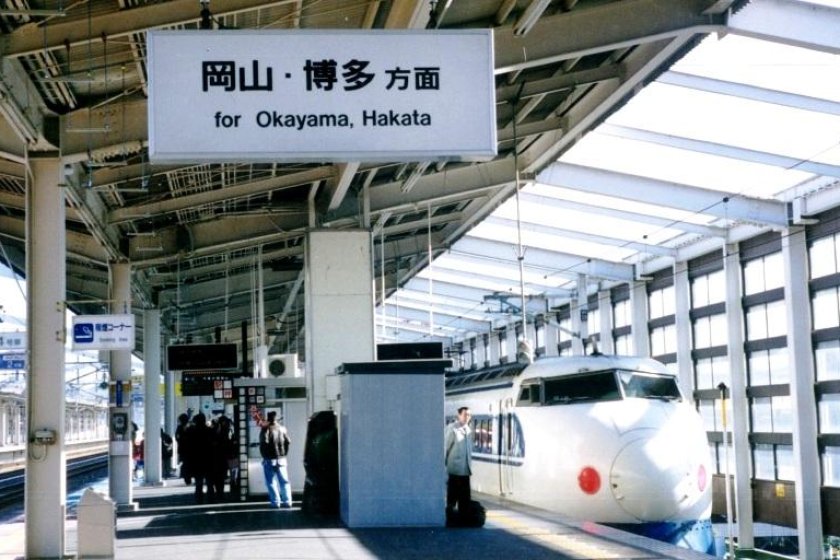
What’s the Best Way to Get From Kyoto to Tokyo?
Options for all budge

The coastal road between Tokyo and Kyoto is called the Tokaido Road, immortalized in the 1800s by a series of ukiyo-e woodblock prints by Utagawa Hiroshige called the Fifty-Three Stations of the Tokaido. Walking its length would have taken twelve days. Government messengers used to run the route, with a change of runners between towns to another to ensure the runners didn’t get too exhausted. This custom eventually led to the modern-day Hakone Ekiden, a relay marathon between Tokyo and Hakone.
These days, however, the Tokaido is better known as the train line between Tokyo and Kyoto and Osaka, snaking its way through Yokohama, Hamamatsu, Nagoya and Gifu. Train is, for many people, the most popular way of connecting the two cities. However, the following options will all take travelers from Kyoto to Tokyo, focusing on a variety of preferences and budgets.
Kyoto to Tokyo by Airplane
The airport bus leaves from the South exit of JR Kyoto Station, and it takes you to Osaka Itami Airport in less than 50 minutes. Being in Japan the flights leave on time, and with two trains, I get to Tokyo in 234 minutes. The total fare averages ¥26,300. Overseas travelers can instead purchase a Yokoso Japan or Japan Air Pass prior to arriving to Japan and fly this sector for ¥10,000.
Recently, low cost carriers (LCCs) like Peach or Jetstar have begun flying from Kansai to Narita for ¥4,000, but be prepared to pay at least another ¥3,000 for the airport trains and potential baggage fees.
Kyoto to Tokyo by Train
Nozomi and hikari shinkansen.
The fastest Shinkansen (bullet train) is the Nozomi, which travels between Kyoto and Tokyo in a time of 154 minutes. The total cost is around ¥13,400 yen.
While Japan Rail Pass holders cannot use the Nozomi (Japanese for hope), the Hikari (Japanese for light) takes only 20 minutes longer.
From Kyoto to Tokyo there are four to five Nozomi bullet trains an hour, while the twice hourly Hikari trains to Tokyo depart Kyoto at :29 and :56 minutes past the hour. From Tokyo to Kyoto (the opposite direction), the Nozomi leaves every 10 minutes, while the Hikari departs every half an hour, at 3 minutes and 33 minutes past the hour from 7 am to 8 pm. For early birds the first train is at 6 am and the last train just after 10 pm.
On Public Holidays there are actually more frequencies around noon for the Nozomi. Every train is needed on the peak vacation periods of New Year, Golden Week and Obon, so if you don’t book well in advance, you might not even get standing room.
Kodama Shinkansen
A third bullet train option, the Kodama Shinkansen, takes close to 240 minutes. This slow train to Tokyo may be the path least taken, but it is brimming with surprises, from kindergarten kids filled with smiles on their first trip on the big train, as well as the opportunity to connect with the quieter parts of Chubu, from the resort gateway of Odawara to the villages by the shadow of Mount Fuji . The Kodama Shinkansen leaves Kyoto at :9 past the hour, with the first Kodama for Tokyo at 8:09 am and the last one at 7:09 pm. Running from Tokyo to Kyoto, the Kodama departs at :26 and :56 minutes past each hour, though you have to change at Nagoya on the :26 past trains.
Special Passes
If you buy a Kodama ticket at least one day in advance, you can purchase the "Puratto Kodama Economy Plan", which gets you a reserved seat for around ¥9,800, instead of closer to ¥12,700 on the day. This is a good option for those without a Japan Rail pass. You can get it at JR Tokai Tours at JR Tokyo or Shinagawa, or at JTB or JTB Traveland counters at Osaka and Nara. In JR Kyoto, the two branches are at the Central Exit, on the second floor, and the Hachijo exit, on the first floor.
Many travelers these days fly in to Kansai and out from Tokyo Narita, so the Puratto Kodama Economy Plan is a cheap option. For a 7-day return Tokyo-Kyoto train ticket, the new Central Japan Flex-Rail Ticket is only a touch more than two single Kodama tickets, but allows you to use non reserved seats on the faster Nozomi as well, plus a one-day Kyoto bus and subway pass worth ¥1,200 yen is thrown in for free. That is ¥27,460 of value for at ¥21,000. With the ¥6,460 in savings, you can stay two nights at a hostel like Hana or Khaosan .
Another option, albeit for travels with plenty of time on their hands, is the Seishun Juhachi Kippu , a vacation period ticket favored by backpackers or those on extreme budgets. This route shuns all bullet trains, and relies only on local trains. To reach Tokyo from Kyoto takes six trains and an average of 512 minutes. It is only ¥2,300, and a “book” of five coupons can be shared between 5 people or used by one person over a period of five days. It can be used from 1st March to 10th April, 20th July to 10th September, and 10th December to 20th January.
Kyoto to Tokyo by Bus
For yet another alternative, buses connect Kyoto and Tokyo and cost from ¥4,000 to ¥10,000, with day or overnight options. If you can’t sleep on the bus, why not try a flatbed on the overnight train , starting from ¥14,600. It is a wonderful way to start a day by waking up in the “Grand Central stations” of Tokyo or Kyoto, and watch the city awaken in the dawn light.
- Share on Facebook
- Share on Twitter
- Copy link to share
By Bonson Lam
Community writer

Information
Shikoji dori Kyoto City 600-8216 ( Directions )
hyperdia.com
Book your trip
Find a nearby hotel, explore nearby.

Tokyo to Kyoto by Shinkansen Train

Dormy Inn Premium Kyoto Ekimae

Nishikiro Ryokan near Kyoto Station
By Sandra Isaka

Kyoto Tower
By Xia Fei Chiew
Top Articles
- Recommended

Guide to Golden Week

2024 Grand Sumo Tournaments

Haneda Airport Ranked World's Cleanest

Valley of Witches: a New Ghibli Park Attraction

Sapporo Beer Opens New Brewery in Tokyo’s Ebisu

Tokyo Takes 2nd Place on Top Coffee Cities List

Tokyo One of the World's Most Walkable Cities

Mount Omuro

Kurobe Unazuki Canyon Route to Link with Tateyama Kurobe Alpine Route

Guide to Bringing Medicines Into Japan

Your Name: Real-Life Locations in Tokyo

Hachiko Statue in Shibuya

Iwatayama Monkey Park

Shibuya Crossing

Daikoku Car Meet

Kanamara Penis Festival

Guide to Suica Cards

Japanese Urban Legends

Guide to PASMO Cards
More from this category.
By Sarah Endarastya

Convenient Bus Travel From Narita..

Major Airports in Hokkaido

Cycling Rules in Japan
By Japan Travel
Join the discussion

Let us know how we can help.
Help us improve JapanTravel.com
We welcome any suggestions regarding this content. Your feedback is confidential and will be used to help improve this page.
Suggest an edit
https://en.japantravel.com/kyoto/best-way-from-kyoto-to-tokyo/4022
Thank you for your support!
Your feedback has been sent.
Kyoto: Getting there and around
Getting to kyoto.
- ¥ around 14,000
- multiple trains per hour
Tokyo and Kyoto are connected with each other by the JR Tokaido Shinkansen . Nozomi trains require about 140 minutes to reach Kyoto from Tokyo, Hikari trains about 160 minutes and Kodama trains about four hours.
The regular one way fare from Tokyo to Kyoto is 13,320 yen for a non-reserved seat or around 14,000 yen for a reserved seat. The Japan Rail Pass is valid on Hikari and Kodama trains, but requires a supplement fee of 4,960 yen on Nozomi trains.
The Tokyo-Osaka Hokuriku Arch Pass is a rail pass that allows holders to travel between Tokyo and Kyoto via Kanazawa , using the Hokuriku Shinkansen . It is not the fastest way to travel between Tokyo and Kyoto, but it allows pass holders to visit the less-explored Hokuriku Region along the way. It costs 24,500 yen and is valid for seven consecutive days.
- ¥ 3,500 - 10,000
- multiple daytime and overnight connections per day
The one way trip from Tokyo to Kyoto by highway bus takes about 7-8 hours. There are daytime and overnight buses. Fierce competition on the Tokyo-Kyoto-Osaka route has produced a wide variety of comfort levels (from discount to super premium buses) and an abundance of low priced offers.
Typical one way fares for discount buses, such as Willer Express , start from around 3500 yen; while premium buses charge up to 10,000 yen. If used effectively, the Japan Bus Pass can reduce the cost for the bus trip to around 3000 yen. Online reservations can be made through Willer and Japan Bus Online .
- 2-3 transfers
- ¥ 9,000 - 23,000
- multiple flights per day
The closest airport to Kyoto is Osaka 's Itami Airport , about one hour by bus from central Kyoto ( more details ). Most flights connect Itami Airport with Tokyo 's Haneda Airport , with just a few serving Tokyo's Narita Airport . Flight duration is one hour. The regular one way fare is around 28,000 yen, but discount tickets are usually available for around 9,000 to 14,000 yen.
- ¥ around 10,000 (expressway tolls)
Driving between Tokyo and Kyoto via the Tomei and Meishin Expressways takes about five to six hours without breaks and traffic jams. The expressway toll is around 10,000 yen one way.
- 4 transfers
- ¥ 2,410 - 8,210
By local trains , the one way trip from Tokyo to Kyoto takes about nine hours and typically involves about four transfers of trains. The regular fare is a relatively expensive 8360 yen, however, with a Seishun 18 Kippu you could theoretically do the trip for as little as 2410 yen.
Above fees and schedules are subject to change. Be sure to check current yen exchange rates .
Getting around
Kyoto features a rectangular street system. Unlike the streets in other Japanese cities, most of central Kyoto's streets are named. The main streets running from east to west are numbered in ascending order from north to south, and are about 500 meters apart from each other, with several smaller streets in between. For example, Shijo means "4th Avenue" and Nijo means "2nd Avenue".
Kyoto's city center with the highest concentration of dining, shopping and entertainment opportunities, is located around the junction of Shijo-dori (4th Avenue) and Kawaramachi-dori (Kawaramachi Street). JR Kyoto Station is located south of the city center at the height of Hachijo-dori (8th Avenue).
The most prominent north-south street is Karasuma-dori (Karasuma Street), which runs from Kyoto Station via the city center to Kyoto Imperial Palace . Another north-south axis is Kamo River, about one kilometer east of Karasuma-dori.
Kyoto has a rather inadequately developed public transportation system for a city of its size, consisting of two subway lines, a dense bus network and several railway companies, whose lines are not always conveniently connected with each other. Taxis and bicycles can be worthwhile alternatives.
The recommended way to get around Kyoto by public transportation is to use an IC card , such as Icoca, which is accepted on virtually all trains and buses in the city. Alternatively, travelers intending to use buses or subways extensively, should consider one of the 1-day passes available. See the ticket section below for more details.
Below is a simplified map of the railway and subway lines of Kyoto:
Few of Kyoto 's tourist attractions are located close to subway or train stations. Instead, Kyoto has a dense bus network with direct bus lines from Kyoto Station and/or the city center around Shijo-dori and Kawaramachi-dori to most major sights.
Kyoto is served by multiple bus companies. For central Kyoto, the green Kyoto City Bus buses are most numerous and useful. The red buses by Kyoto Bus are second most prominent and tend to be convenient to access sights in more outlying areas of the city.
The tourist offices provide a useful English network map for the Kyoto City Buses, which makes it quite easy for foreign visitors to access tourist attractions by bus. Despite the good map and English displays and announcements, however, getting off at the correct bus stop can still be stressful, especially in crowded buses.
Since buses are small and operate surprisingly infrequently even on some major routes, buses to major tourist sights can often get crowded, especially on weekends and during holidays. In addition, much time can be lost when buses get stuck or only proceed slowly in the busy street traffic. Consequently, it is recommended to use subways and trains as much as possible, and use buses only for medium and short distances, for example, from the closest subway station to the destination.
Most buses are entered through the back door and left through the front door. The fare has to be paid when leaving the bus. Inside much of central Kyoto, there is a flat rate of 230 yen per ride. Outside the flat fare zone, the fare increases with the distance. Click here for more information on riding buses.
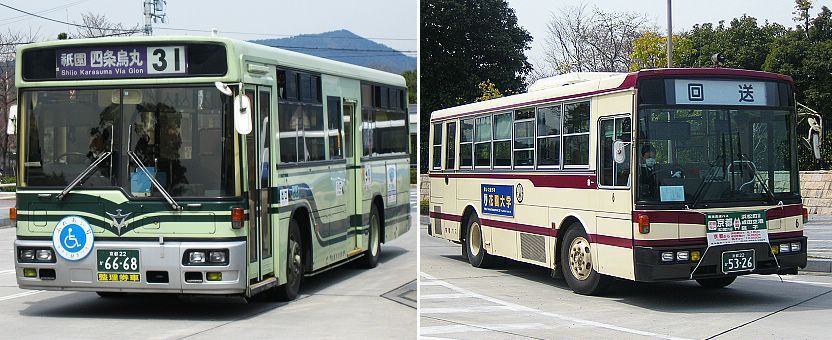
There are two subway lines in Kyoto , the Karasuma Line which runs from south to north along Karasuma-dori and stops at JR Kyoto Station, and the newer Tozai Line which runs from east to west and meets the Karasuma Line at the intersection of Karasuma-dori and Oike-dori.
Japan Railways
All JR lines, including the Tokaido Shinkansen , pass through or commence at JR Kyoto Station . JR trains can be a convenient for accessing the Arashiyama area (JR Sagano Line) and some attractions in southern Kyoto along the JR Nara Line, e.g. Fushimi Inari Shrine and Uji .
Other Railways
- Hankyu Railway connects Kyoto with Osaka . The line initially runs below Shijo Avenue from Kawaramachi westwards in direction of Osaka. It is a good option for accessing the area around Katsura Rikyu , from where a branch line also connects to Arashiyama .
- Keifuku Railway (also known as Randen) operates two tram-like train lines in northwestern Kyoto. For train lovers, a ride on these trains is a small attraction by itself. The lines can be an option for accessing Arashiyama and the area around Ryoanji and Kinkakuji .
- Keihan Railway 's main line runs next and parallel to Kamo River, but unfortunately does not connect to Kyoto Station . The line continues to Osaka and is an alternative to the JR Nara Line to access some of the attractions in southern Kyoto.
- Eizan Railway operates two train lines from where the Keihan Line ends, Demachiyanagi Station. One line leads to Kurama , while the other runs to the base of Hieizan .
- Kintetsu Railway connects Kyoto Station to Nara . Note that some trains on the Karasuma Subway Line continue to run on the Kintetsu Nara Line and the other way around.
By sightseeing bus
The Sky Hop Bus is an expensive but convenient way to visit Kyoto's most famous sightseeing spots. Double-decker buses with an open-air second floor run clockwise every hour from Kyoto Station in a large circle around the city, stopping near major tourist sites along the way, including Nijo Castle , Kinkakuji , the Imperial Palace , Heian Shrine and Kiyomizudera . A 12-hour pass costs 2500 yen and a 24-hour pass costs 3600 yen and can be purchased through Klook .
Kyoto is probably the Japanese city with the highest concentration of taxis . Especially in the city center, taxis are found everywhere. Taxis can not only be a more comfortable, but also an economical alternative to buses on short to medium distances for groups of three or more.
Most taxis accommodate up to four passengers (not including the driver), while larger vehicles are able to accommodate an additional fifth passenger. The rate starts around 610 yen for the first two kilometers and increases by 80 yen for every additional 300-400 meters traveled.
Kyoto City's simple layout and flat terrain make it easy and convenient to explore by bicycle . Numerous bicycle rental outlets can be found around the city, especially around major stations, such as Kyoto Station or in popular biking areas like Arashiyama . Typical rental prices are around 1000-1500 yen per day for basic bicycles and around 1700-2000 yen for electric assist bicycles. Some lodgings may provide their guests with bicycles for a small fee or for free.
Kyoto is generally a bicycle-friendly city with relatively easily navigable roads and a handful of cycling routes, most notably along Kamo River. Designated bicycle parking is often freely available around popular sightseeing spots. The situation is a little bit more challenging in the city center due to congested roads, crowded sidewalks and a lack of designated parking areas. Also, distances to some of the more outlying sightseeing spots should not be underestimated. For example, it is about eight kilometers (typically a 45-75 minute ride) from Kyoto Station to Kinkakuji or about ten kilometers to Arashiyama .
Passes and Tickets
See also our separate page about the various passes available for the Kansai Region .
The prepaid IC card available in Kyoto is called Icoca . It does not give you any discounts over regular tickets, but it makes the process of taking trains and buses easier, as you do not always need to buy a ticket for each ride. Icoca cards can be purchased through ticket machines at JR stations. Local non-JR railway companies offer their own IC card called Pitapa ; however, Pitapa is a postpaid card that works more like a credit card and is targeted at residents.
Icoca and Pitapa can be used on virtually all trains and buses in and around Kyoto (and most other major cities in Japan). Additionally, eight other IC cards from other major cities of Japan can also be used on the trains and buses of Greater Osaka and Kyoto, including Suica, Pasmo, Kitaca, Toica, Manaca, Sugoca, Nimoca and Hayakaken.
The Kansai One Pass is a special version of Icoca exclusively for foreign tourists that additionally qualifies for discounts at various attractions in the Kansai Region . It is available for sale at Kansai Airport and major railway stations in the Kansai Region.
Furthermore, the following one day passes are available for Kyoto :
- Kyoto Sightseeing Card (1100 yen) Unlimited use of Kyoto's two subway lines and most buses (including Kyoto City Buses, Kyoto Buses, JR buses and Keihan buses) in central Kyoto and outskirts, including Ohara and Daigoji on one calendar day. The pass also comes with discount coupons for selected sights in Kyoto. It can be purchased from ticket machines in subway stations, at bus ticket centers and from some hotels. The pass can pay off especially if you visit outlying areas such as Ohara . The downside is that, besides the subway lines, the pass does not cover any other trains which are often a convenient means of getting around.
- Kyoto Subway One Day Card (800 yen) Unlimited use of Kyoto's two subway lines on one calendar day. The card can be purchased from ticket machines at subway stations. It generally pays off if you use subways more than three times per day, however its value is restricted by the subway's limited coverage area.
Questions? Ask in our forum .
Links and Resources
Arukumachi kyoto route planner, kansai one pass, kyoto municipal transportation bureau, keihan railway, kintetsu railway, hankyu railway, kansai airport transportation, osaka airport transport, sky hop bus, enjoy cycling in kyoto, keifuku railway, eizan railway, hotels around kyoto.
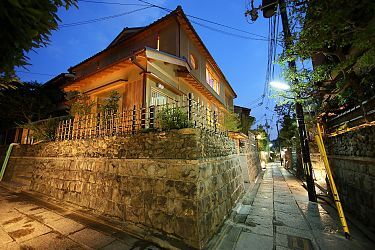
Experiences around Kyoto
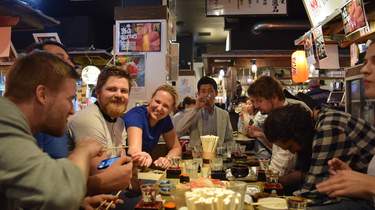
Kyoto to Tokyo Train
Kyoto to tokyo trains information.
Travel Time
Approximate
Ticket Cost:
Kyoto to Tokyo Trains Schedule
Shinkansen trains from Kyoto to Tokyo are definitely among the top choices when it comes to discoveringJapan wonders. Within 475 kilometers (295 miles) of each other, the cities are connected by one of the country's most scenic railroad routes, ideal for admiring the country's breathtaking landscapes, and served by the record-breaking Nozomi trains.
Kyoto to Tokyo Train Map
An undeniable advantage of taking a Kyoto to Tokyo Shinkansen is, of course, unparalleled comfort during the journey, as Nozomi trains serving the route are famous for their great onboard amenities. There have three travel classes, offering various levels of comfort, so you can easily choose an option that works best for you. What is more, these trains are astonishingly fast! Kyoto to Tokyo train time is just 2 hours, can you believe it? A broad departure schedule with up to 31 departures every day is basically an acing on a cake. As you can see, taking a train is the smartest choice when you need to travel from Kyoto to Tokyo. Unsurprisingly, train tickets are always in high demand, so make sure to book yours in advance (we recommend using Rail Ninja ).
Book Japanese Train Tickets
Q&a: travel from tokyo to kyoto.
HOW FAR IS KYOTO FROM TOKYO BY TRAIN?
HOW OFTEN DO TRAINS RUN FROM KYOTO TO TOKYO?
WHERE CAN I BUY A BULLET TRAIN TICKET FROM KYOTO TO TOKYO?
The system is pretty much the same as everywhere else. The old-time classic option is to get a Kyoto - Tokyo train ticket at the station before the departure. A valid choice, of course, but there is always a chance to miss your train because the tickets are sold-out or the line at the checkout is huge. So consider buying a Shinkansen rail ticket online via Rail Ninja . It's fast and easy, and a one-way ticket from Kyoto to Tokyo costs about 160 USD (you can learn more about the types and prices of Japanese train tickets here ).
Explore More of Japan
Tokyo to kyoto train, kyoto to osaka train, osaka to tokyo train, hiroshima to tokyo train.

- WHERE TO GO
- CHERRY BLOSSOMS
- FALL COLORS
Shinkansen! Kyoto to Tokyo train with JR pass (and cost without) 🗾🚊 Japan travel blog
So you want to go from Kyoto to Tokyo!
It’s easy to get to Tokyo from Kyoto!
You can use a JR pass to take the famous Japan train aka shinkansen!
(You can also take the famous shinkansen without a JR pass!)
It will depend on which type of shinkansen train you take, but you can expect the bullet train from Tokyo to Kyoto to be around 2 hours and 15 minutes (without JR pass) and 2.5 hours (with JR pass).
The reason for the difference in time with or without the JR pass is because the JR pass is not accepted for the fastest shinkansen train called the Nozomi.
So if you are traveling with a JR pass, then you need to take the next fastest shinkansen (which is still fast!) and that’s the Hikari.
The shinkansen is the bullet train.
This is the fastest train in Japan.
The difference between the Nozomi and Hikari is the amount of stops they make along the route.
You will get the same Japan shinkansen experience no matter which train you take. (The inside is the same.)
To note, there is an even “slower” shinkansen train, called the Kodama.
This is slower because it makes even more stops.
You could take this train with a JR pass, but you don’t want to, because it will take much longer to get to Tokyo!
There are other (slower and cheaper) ways to get from Kyoto to Tokyo, like taking the long-distance bus . The only reason to consider this is if you are traveling without a JR pass!
But taking the shinkansen from Kyoto to Tokyo is the best way to travel not only so you can get there fast, but so you can have one of the classic Japan experiences!

How to get from Kyoto to Tokyo by shinkansen train
Important stops to know about when you want to go from Kyoto to Tokyo by bullet train:
- Kyoto Station (you will start here in Kyoto!)
- Shinagawa Station (your possible train destination in Tokyo)
- Tokyo Station (your possible train destination in Tokyo)
Google maps makes travel around Japan super easy, and that includes getting from Tokyo and Kyoto!
It will also tell you the approximate cost of a train trip to help you figure out if a JR pass is worth it for you.
Now, in the case of the Kyoto to Tokyo train, google maps will tell you about the fastest way to get there.
This means that it will tell you about the train timings for the Nozomi shinkansen train.
So if you are traveling with a JR pass (which means you can’t travel on the Nozomi), you won’t get the perfect train timings, but it will give you an idea.
The Hikari shinkansen train (that you want to get on to go to Kyoto with a JR pass) doesn’t depart as frequently as the Nozomi, but it is still frequent enough. (Maybe once every 30 minutes instead of once every 10-15 minutes.)
On google maps, you can enter Kyoto Station as your starting point and then also your destination within Tokyo. Then select the public transportation option!
Then it will tell you which Tokyo shinkansen station will be best for you to get off at, Shinagawa Station or Tokyo Station.
If you are just doing general planning right now, then you can enter Tokyo Station as your destination. There will not be much of a difference from Shinagawa Station.
Because the train timings between Kyoto and Tokyo are so frequent, it may not matter as much, but in general when using google maps to plan public transport in Japan, it can be helpful to change the departure time to a time that you might be leaving. (Try the morning for the best results.)
If the current time is at night, the suggested route may be unhelpful!
Google maps also gives you alternate routes and the approximate cost of any particular train route.
If you are traveling without a JR pass, you can buy train tickets when you get to the train station. The ticket machine has an English option you can select.
Or if you see a manned ticket booth, it can be easiest to buy your ticket from a person. (Kyoto Station has a JR office that you can walk into and buy shinkansen tickets.)
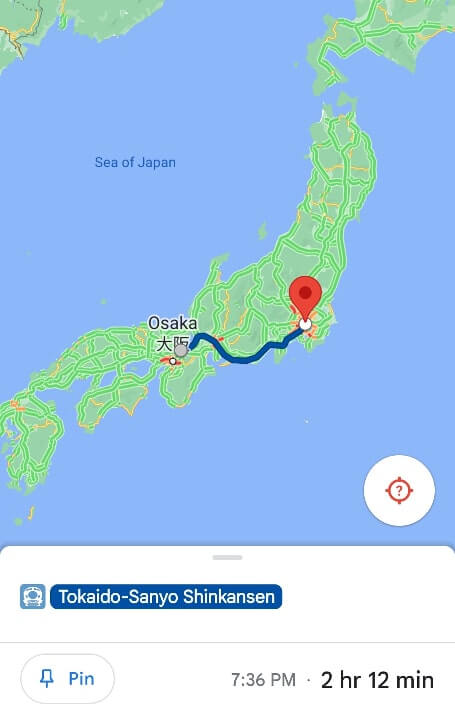
The cost of the Kyoto to Tokyo shinkansen bullet train route is around 14,200 yen (around US$100) one-way without a JR pass. (Approximate USD can vary! The $100 estimate is based on US$1 = 148 yen as of November 2022.)
If you take the Hikari shinkansen from Kyoto to Kyoto, it’s FREE with a JR pass!

Then, once you get to Tokyo Station or Shinagawa Station, continue to follow what google maps tells you for your transfer to the next train!
For an example of how to transfer between trains in Tokyo (aka a visual!) have a look at how to transfer from Shinagawa Station to Shinjuku Station !
For local travel around Tokyo, it’ll be convenient to have a SUICA card or PASMO card when you can’t use your JR pass.
Or, if you already got an ICOCA card when you were in Kyoto, you can use that in Tokyo too!
HAPPY TRAIN RIDE FROM KYOTO TO JAPAN!
Check the homepage on the blog if you’re still looking for where to go in Japan!
Here are ideas for your Kyoto itinerary !
- Day 1: Top tourist spots with one day bus pass
- Day 2: Fushimi Inari Shrine hike through 1,000 torii gates
- Day 3: Philosopher's Path walk
- Day 4: Arashiyama and Sagano
- Day 5: Kurama Kibune Ohara with one day pass
PLUS Kyoto cherry blossom itinerary and Kyoto fall colors itinerary !
Is a jr pass worth it.
- Google maps can make it easy to figure out whether or not you should get a JR pass!
- In google maps, type in your departure and arrival city, and choose the transit icon. The route will come up, and so will the estimated cost at the bottom!
- Here is an example of a train route with cost on google maps.
- So do that for all of your long distance routes to figure out how much it might cost.
- Next, go here to see how much a JR pass costs from an official JR pass vendor (and partner of this website).
- And compare!
- Not all forms of public transportation are JR, but long distance shinkansen bullet trains are, and that's where the most cost savings will come.
Best of Kyoto (and Japan!)
- Best temples to visit in Kyoto
- Japanese gardens in Kyoto
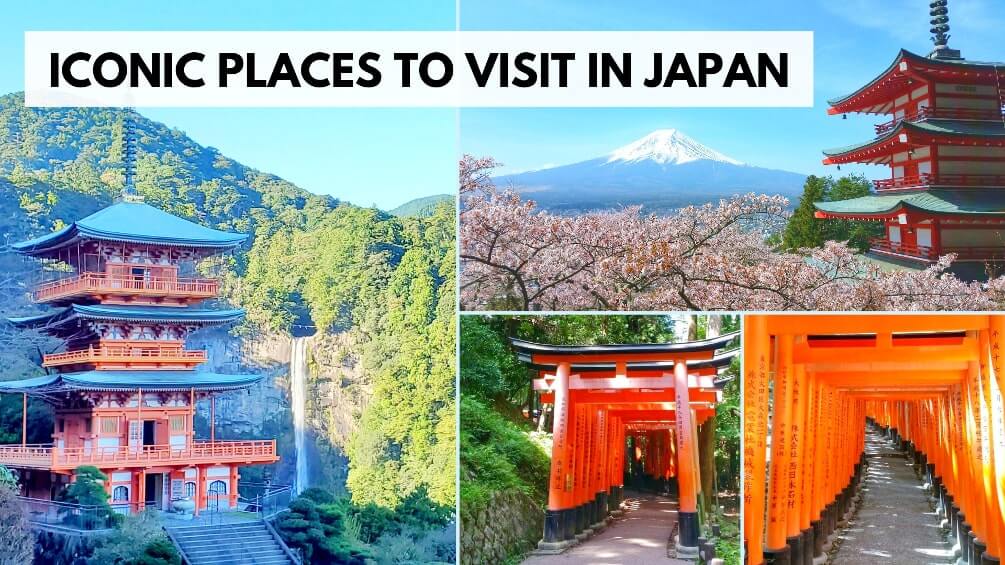
Truly Tokyo
A Tokyo Travel Guide
How To Travel From Tokyo To Kyoto
It's very easy to travel between Tokyo and Kyoto. The shinkansen (bullet train) takes around 2 hours and 15 minutes and costs Y13,080. Read on for full details.

The Takeaway
- The shinkansen (bullet train) is the best way to travel between Tokyo and Kyoto.
- It takes around 2 hours and 15 minutes and costs Y13,080 between Tokyo and Kyoto(non-reserved seat).
- You don't need to reserve seats on the shinkansen if you travel outside of peak travel hours and outside of peak travel seasons.
- You can also purchase Tokyo to Kyoto shinkansen tickets online .
- See below for English-language shinkansen timetables.
- There are also night buses between Tokyo and Kyoto if you want to save money.
The Details
Shinkansen (bullet train) between tokyo and kyoto.
- The best way to travel between Tokyo and Kyoto is the shinkansen (bullet train). The fastest type of shinkansen, called the Nozomi, takes around 2 hours and 15 minutes and costs Y13,080 for a one-way trip in an unreserved seat. Note that you cannot ride the Nozomi shinkansen with a Japan Rail Pass , but you can ride the next fastest type of shinkansen, which is called the Hikari. The Hikari takes about 2 hours and 30 minutes between Tokyo and Kyoto, so it's almost as fast. Do NOT take the slowest type of shinkansen (the Kodama) as it stops a lot and is much slower.
- In Tokyo, you can catch the shinkansen at Tokyo Station or Shinagawa Station. All shinkansen stop at both stations. I like to get on at Tokyo Station because it's the first station so I can usually get a seat. However, if I'm coming from Kyoto and want to switch to the Narita Express, I sometimes switch at Shinagawa, because it's a short walk from the shinkansen platforms to the Narita Express platforms at Shinagawa and it's LONG hike at Tokyo Station. This would also hold true in the opposite direction (ie, if you want to switch between the Narita Express and the shinkansen and go straight to Kyoto, it's easier to switch at Shinagawa).
- In Kyoto, the shinkansen leave and arrive at the shinkansen platforms on the south side of Kyoto Station (clearly marked from everywhere).

Do You Need Reserved Seats on the Shinkansen?
- Normally, you don't need a reserved ticket to get a seat on the shinkansen. Just buy an unreserved ticket and show up and board the next shinkansen going your way. However, if you are traveling at rush hour (between 7am and 9am and 4pm and 7pm) or during peak travel seasons (31 Dec-3 Jan; the first week of May and mid-August), consider buying reserved tickets in advance. With a Japan Rail Pass, you can make reservations at any JR ticket window, up to one month in advance of your travel. You cannot reserve from overseas. HINT: If you have unreserved tickets and you find that the unreserved cars are full on the next train heading out, just stand in line at the boarding spot for the next train so you can board it first – this will usually guarantee a seat and you probably won't have to wait more than 15 minutes. If you book shinkansen tickets through an online agent like Klook, you can make seat reservations when you buy your ticket.
Check Hotel Availability
Destination, check-in date, check-out date.

First and Last Shinkansen Departures
- During the day, there are several shinkansen every hour between Tokyo and Kyoto. You rarely have to wait more than 10 minutes for a train. The approximate first and last departures are listed below:
- Westbound (Tokyo-Kyoto): 6:00am first / 7:50pm last
- Eastbound (Kyoto-Tokyo): 6:14am first / 9:30pm last
Shinkansen Schedules and Timetables
- English-language shinkansen timetables: JR Central English Site
- English-language timetable and route search: HyperDia
Willer Express Bus Between Tokyo and Kyoto
- If you're on a tight budget, you can save a lot of money by taking a Willer Express bus between Tokyo and Kyoto. These buses take around 8 hours and cost about Y7,000. In Tokyo, these buses operate from the Willer bus terminal in West Shinjuku. In Kyoto, these buses operate from Gion Shijo Station. For more information and online ticket purchase in English, visit the Willer Express Bus site .
JR Night Bus Between Tokyo and Kyoto
- Another cheap option for traveling between Tokyo and Kyoto is a JR night bus. These night buses take about 7 hours and 30 minutes and cost an average of Y9,400. In Tokyo, they leave from the JR bus terminal outside the Yaesu South Exit in front of Tokyo Station. In Kyoto, they leave from the JR bus terminal in front of Kyoto Station. Unfortunately, there is no English-language site for JR highway buses. So, for inquiries and ticket purchase, go to any JR ticket window or any travel agent in Japan. There is, however, a Tokyo - Kyoto Night bus service available to book online via Klook.
Tokyo Vacation Checklist
- For all the essentials in a brief overview, see my First Time In Tokyo guide
- Check Tokyo accommodation availability and pricing on Booking.com and Agoda.com - often you can book with no upfront payment and free cancellation
- Need tips on where to stay? See my one page guide Where To Stay In Tokyo
- You can buy shinkansen (bullet train) tickets online from Klook - popular routes include Tokyo to Kyoto , Tokyo to Osaka and Tokyo to Hiroshima
- You can buy a Japan SIM card online for collection on arrival at Tokyo Narita or Haneda airports. Or rent an unlimited data pocket wifi router
- See my comprehensive Packing List For Japan
- Compare airline flight prices and timings for the best Japan flight deals . Check my guides to arriving at Narita Airport and at Haneda Airport .
- If you're visiting more than one city, you might save money with a Japan Rail Pass – see if it's worth it for you
- A prepaid Welcome Suica card makes travelling around Tokyo much easier - here's how
- World Nomads offers simple and flexible travel insurance. Buy at home or while traveling and claim online from anywhere in the world
Tokyo District Map

- Imperial Palace Area
- Tokyo Station
- Shimbashi Shiodome Hamamatsucho Shinagawa
- Akihabara Kanda
- Roppongi Akasaka
- Harajuku Aoyama
- Ebisu Daikanyama Meguro
Disclosure: trulytokyo.com is a participant in the Amazon Services LLC Associates Program, an affiliate advertising program designed to provide a means for sites to earn advertising fees by advertising and linking to amazon.com and amazon.co.uk. World Nomads provides travel insurance for travellers in over 100 countries. As an affiliate, we receive a fee when you get a quote from World Nomads using this link. We do not represent World Nomads. This is information only and not a recommendation to buy travel insurance.
Inside Kyoto
A Kyoto Travel Guide
- 1 Week Japan Itinerary: Tokyo and Kyoto
If you’ve got about a week to spend and this is your first trip to Japan, this Classic Japan itinerary is for you. You’ll experience modern Japan in Tokyo and traditional Japan in Kyoto.

Itinerary Summary
- Duration: 7 to 10 days
- Perfect for: First time visitors to Japan with limited time.
- Cities visited: Tokyo and Kyoto
- Arrival City/Airport: Most people fly into Tokyo’s Narita or Haneda airports to do this itinerary. You can also fly via Kansai International Airport (KIX), which is the nearest international airport to Kyoto/Osaka.
- Best Season: Any time of year.
- Japan Rail Pass: A one-week Japan Rail Pass may save you a bit of money. For more details, see our Japan Rail Pass: Is It Worth It? page.
Hire A Travel Expert To Plan Your Japan Itinerary
Check hotel availability, destination, check-in date, check-out date.

How much time should you spend in Tokyo and Kyoto?
A crucial question you must ask yourself is how much time to allot to each city. For most people, the ideal breakdown is 2 full days in Tokyo and 4 full days in Kyoto (travel days are not considered full days). If you are more interested in modern Japan, then you could spend 3 days in Tokyo and 3 in Kyoto. For most people, Kyoto is more relaxing and more manageable, so spending more time in Kyoto results in a more enjoyable vacation.

The Full Itinerary
Day 1: Arrive in Tokyo You’ll probably arrive at Narita International Airport (NRT), but some flights also go into the more convenient Haneda International Airport (HND). See our Tokyo Airport Transport page for details on getting into Tokyo from the airports.
Day 2: Tokyo: Modern Tokyo On your first full day in Tokyo, you’ll explore the modern west side of the city. See our full Tokyo Two-Day Itinerary for details.
Day 3: Tokyo: Traditional Tokyo On your second full day in Tokyo, you’ll explore the traditional east side of the city. See our full Tokyo Two-Day Itinerary for details.

Day 4: Travel to Kyoto, Explore Downtown Kyoto Take the shinkansen from Tokyo to Kyoto. The journey takes around 2.5 hours. For details, see our How to Travel from Tokyo to Kyoto page. You’ll probably have some time after arriving in Kyoto to explore. We recommend checking out the downtown area on this day.
Day 5: Kyoto: Southern Higashiyama On your first full day in Kyoto, you’ll explore the temple-packed Southern Higashiyama area. See our full Kyoto Three-Day Itinerary for details.
Day 6: Kyoto: Arashiyama On your second full day in Kyoto, travel west to the Arashiyama district, which is home to the famous Arashiyama Bamboo Grove. See our full Kyoto Three-Day Itinerary for details.
Day 7: Kyoto: Kurama and Northern Higashiyama On your last full day in Kyoto, consider a trip to Kurama and then explore the lovely Northern Higashiyama area. See our full Kyoto Three-Day Itinerary for details. Another option on this day would be a day or half-day trip to Nara. For information on Nara, see our full Nara guide .
Day 8: Travel from Kyoto back to Tokyo Take the shinkansen back to Tokyo. For details, see our How to Travel from Tokyo to Kyoto page. You’ll probably have some time in the afternoon to do some last-minute shopping or sightseeing. Note, if your flight out of Tokyo leaves after 3pm, you might be able to spend this night in Kyoto (see the note below).
Day 9: Leave Japan Return to Narita or Haneda airport and fly home. See our Tokyo Airport Transport page for transport details.
Important Note on Leaving Kyoto and Flying Out of Tokyo the Same Day
If your departure from Tokyo is after 3pm, you do not have to spend your last night in Tokyo; you can leave from Kyoto and still make your flight. As a rule, to travel from Kyoto to Narita takes around 4 hours, with transfers. The best way is to take a Hikari or Nozomi shinkansen to Shinagawa Station in Tokyo and transfer to the Narita Express there (if you change at Tokyo Station, you have to walk VERY far to reach the Narita Express platforms).
If you you’re flying out of Haneda Airport, allow about 3.5 hours travel time from Kyoto to Haneda. The best way is a Hikari or Nozomi shinkansen to Shinagawa Station in Tokyo and then the Keikyu Line to Haneda.
Japan Itineraries:
- Japan Itineraries Overview
- 10 Day Japan Itinerary: Tokyo, Kyoto and Kanazawa
- 10 Day Japan Itinerary: Tokyo, Kyoto and Takayama
- 2 Week Japan Itinerary: The Grand Tour
- 7 to 10 Day Japan Itinerary: Kyoto, Osaka, Nara and Hiroshima
- Japan With Children Itinerary
Kyoto Vacation Checklist
- For all the essentials in a brief overview, see my First Time In Kyoto guide
- Check Kyoto accommodation availability on Booking.com and Agoda.com - often you can book with no upfront payment and free cancellation
- You can buy shinkansen (bullet train) tickets online from Klook - popular routes include Tokyo to Kyoto , Kyoto to Osaka and Kyoto to Tokyo
- Need tips on where to stay? See my one page guide Where To Stay In Kyoto
- See my comprehensive Packing List For Japan
- Buy a data-only SIM card online for collection when you arrive at Kansai International Airport (for Osaka and Kyoto) or Tokyo's Narita Airport . Or rent an unlimited data pocket wifi router
- Compare Japan flight prices and timings to find the best deals
- If you're making frequent train journeys during your visit, you might save money with Japan Rail Pass – see if it's worth it for you
- A prepaid Welcome Suica card makes travelling around Kyoto easy – here's how
- World Nomads offers simple and flexible travel insurance. Buy at home or while traveling and claim online from anywhere in the world
Kyoto District Map

- Central Kyoto
- Northwest Kyoto
- Northern Higashiyama
- Southern Higashiyama
- Downtown Kyoto
- Kyoto Station Area
- South East Kyoto
Disclosure: InsideKyoto.com is a participant in the Amazon Services LLC Associates Program, an affiliate advertising program designed to provide a means for sites to earn advertising fees by advertising and linking to amazon.com and amazon.co.uk. World Nomads provides travel insurance for travellers in over 100 countries. As an affiliate, we receive a fee when you get a quote from World Nomads using this link. We do not represent World Nomads. This is information only and not a recommendation to buy travel insurance.
- Tokyo Cheapo (繁體中文)
Tokyo to Kyoto: The Fastest and Cheapest Ways to Travel
Kyoto is such a popular destination from Tokyo, and there are many ways to make the trip. The bullet train (aka the Shinkansen) — our favorite way to travel — can get you there in under 2.5 hours; other budget options include cheap flights and highway buses.
How to get from Tokyo to Kyoto
Kyoto is about 370 kilometers (225 miles) west of Tokyo. It’s part of the Kansai region, and thus actually much closer to Osaka : the two cities are about 30 minutes apart on the train. Coming from Tokyo, you’ll reach Kyoto before Osaka.
Top choice: Shinkansen
The fastest, easiest, and most convenient option is the Shinkansen, especially if you have a Japan Rail Pass . The cheapest option is usually a highway bus, followed by flights — but these are both a bit time-consuming.

Comparing Tokyo to Kyoto travel options
Here’s a quick overview of all the different types of transport.
Taking the Shinkansen from Tokyo to Kyoto
From ¥ 13,320 2 hours and 15 minutes (fastest service) Buy a one-way ticket on Klook or Rakuten Travel Experiences , or a JR Pass in advance
The Tōkaidō Shinkansen connnects Tokyo and Kyoto (and terminates one stop further, at Shin-Osaka Station). It’s a direct route, so you won’t usually need to transfer. There are three services on this line: Nozomi, Hikari, and Kodama; the travel time and cost varies by service.
Tōkaidō Shinkansen services to Kyoto
Nozomi is the fastest service on the Tōkaidō Shinkansen, and for this reason it costs a little bit extra. Note that the JR Pass covers travel on all services, including Nozomi.
Note: If you’re traveling during off-peak season, you can knock ¥ 200 off the reserved seat price. During peak season it’s an extra ¥ 200 (and an extra ¥ 400 during super-peak season). For more information on seasonal price fluctuations, see our breakdown of how Shinkansen fares are calculated .
Hikari and Kodama services are priced the same, even though Kodama services take signficantly longer — taking between 3.5 hours and 4 hours to make the trip between Tokyo and Kyoto!
Kodama services also stop at more stations, like Odawara, which is convenient if you want to work in a visit to Hakone on the way from Tokyo to Kyoto.

Departing Tokyo for Kyoto
You can board any Tōkaidō Shinkansen service for Kyoto Station at Tokyo Station , Shinagawa Station, or Shin-Yokohama Station. Ticket prices are the same whether you depart from Tokyo Station or Shinagawa Station. From Shin-Yokohama, the fare is cheaper by ¥ 670 .
After Shin-Yokohama, Nozomi services make one additional stop at Nagoya before Kyoto; meanwhile, Hikari and Kodama services make more stops along the way.
Arriving at Kyoto Station
Unlike some destinations, where the Shinkansen station is outside the city center, Kyoto Station is right in central Kyoto. You can transfer easily to local trains and buses, the city subway, or catch a taxi.

How often does the Shinkansen run from Tokyo to Kyoto?
The Tōkaidō Shinkansen is the most popular bullet train route in the country, with trains departing from Tokyo for Kyoto approximately every 10 minutes. There are PDF timetables here , or you can use navigation apps to plan your journey.
Seat reservations on the Shinkansen to Kyoto
The frequency of trains doesn’t mean you should board without a seat reservation. Opting for a non-reserved seat ( jiyūseki ) will save you a few hundred yen (see pricing above) — but could see you standing awkwardly the whole way to Kyoto.
Our advice (especially if traveling during rush hour and peak periods) is, if possible, to use those extra coins to get a reserved seat ( shiteiseki ). You can arrange this easily at JR ticket offices or at specially marked ticket machines.
You can even make seat reservations when activating your JR Pass, if you have one (reservations are free with the pass).
If you’re committed to non-reserved seats, just get to the station well before your planned departure time — so you can line up in the designated places on the platform to snag a seat. It’s also better to board the train at Tokyo Station, where the route begins, rather than get on one stop later at Shinagawa Station.

Buying Tokyo to Kyoto Shinkansen tickets
If you can’t get a JR Pass , or you’re only interested in traveling one way by Shinkansen to Kyoto, Klook offers a Shinkansen ticket service that can deliver your ticket to your accommodation. Prices are as charged by JR, but Klook adds a ¥ 1,200 fulfillment fee on top.
Another option is the discounted Shinkansen and Kyoto 1-day pass combo ticket, available on JTB . You’ll get a few hundred yen off the regular price.
You can also buy Shinkansen tickets at the station. Read our complete guide to buying Shinkansen tickets .
Luggage rules on the Tōkaidō Shinkansen
If you have a lot of luggage, or even one huge bag, consider sending it on ahead with a luggage delivery service. Shinkansen luggage rules dictate that luggage with combined dimensions of over 160cm but under 250cm will require special reservations (included in your JR Pass). Bags over 250cm won’t be allowed onboard the bullet train at all!
What rail passes cover the Shinkansen from Tokyo to Kyoto?
The only rail pass that covers travel on the Tōkaidō Shinkansen is the country-wide Japan Rail Pass . But from October 2023, using an All Japan Rail Pass for this journey only makes sense if you are visiting more places around the country as well.
There is, however, one regional rail pass that you can use to travel between Tokyo and Kyoto: the Hokuriku Arch Pass . The catch? You can’t use the Tōkaidō Shinkansen; instead, you use a combination of other Shinkansen lines and JR Limited Express lines to travel along an arching route from Tokyo to Kyoto via Nagano and Kanazawa .
Note: The JR Pass and the Hokuriku Arch Pass are only available to short-term visitors to Japan.
Discounts for Shinkansen tickets to Kyoto
Puratto Kodama Economy Plan allows travel on the slow Kodama service from Tokyo to Kyoto for [price amount=10600]–[price amount=12000] one way, depending on the season. You have to buy Puratto tickets at least 1 day in advance, and numbers are limited. Purchase them from JR Tokai Tours or from any JTB Travel counter in Tokyo.-->
Low-cost flights from Tokyo to Kyoto
From ¥ 4,000 (one-way) + travel cost to/from the airport 90 minutes (flight time) + travel time to/from the airport Narita Airport or Haneda Airport to Kansai International Airport (KIX)
The nearest, most convenient airport to Kyoto is Kansai International Airport, which is not really that close to Kyoto. While the flight time is minimal — quicker than the Shinkansen — it’s the time spent getting to and from the airports that adds up.
You’ll need more than an hour on each end, just for travel to and from the city center. Or a minimum 30 minutes on the Tokyo side if you use Haneda Airport instead of Narita. That extra travel costs extra money, too.
Prices for flights start around ¥ 4,000 to ¥ 6,000 one way, but can go for twice as much. There are promo fares and sales every so often, so be on the lookout.

Departing Tokyo
Currently, StarFlyer is the only one of Japan’s budget airlines flying the Haneda–KIX route. All other LCCs depart from Narita Airport, which means you need to factor in the time and cost of traveling between Tokyo and Narita Airport . You need to budget around 90 minutes for this journey, and a minimum of ¥ 1,000 .
It’s generally quicker and cheaper to travel between central Tokyo and Haneda . You can do it by public transport from most center city districts in about 30 minutes. However, flights from Haneda are often more expensive.

Arriving at Kansai International Airport
Once you land at Kansai Airport, you’ll have to board a train or bus to Kyoto .
The JR Haruka Ltd. Express service connects Kansai Airport to Kyoto in 75 minutes. The ride costs about ¥ 3,630 one-way in high season. However, discounted tickets can be purchased online (foreign passport holders only) for as little as ¥ 1,800 .
ICOCA & Haruka package deal
For short-term visitors, we recommend getting an ICOCA & Haruka package at the airport station ticket office. This is a good deal at ¥ 3,800 one-way (and ¥ 5,600 for a round trip).
In addition to transport from the airport, you get an IC travel card called ICOCA that comes with an initial balance of ¥ 1,500 . You can use this card to pay for rail and bus travel in Kyoto and around Japan.
Note 1: Residents of Japan cannot buy this package. Note 2: The route from Kansai Airport to Kyoto is also covered by the JR Pass and most JR West regional rail passes.
What about Osaka’s Itami Airport?
Low-cost carriers generally don’t fly into Osaka Itami Airport. You can book flights from Tokyo’s Haneda Airport to Osaka Itami Airport on legacy carriers like JAL and ANA. However, you are still looking at a 1-hour bus ride into Kyoto (or multiple train transfers).
Highway buses to Kyoto from Tokyo
From ¥ 3,100 one-way 7 hours or more
Several different companies operate highway buses along the route between Tokyo and Kyoto (and nearby Osaka). A ride starts from as little as ¥ 3,100 and can go up to around ¥ 12,000 , depending on comfort and season.
The journey takes about 7 to 9 hours. Buses that depart from Tokyo during the day usually take longer due to traffic. Late-night buses, which are the preferred option, depart Tokyo between 9 p.m. and midnight, and can get you to Kyoto Station as early as 5:15 a.m., giving you a full day to explore.

Play around on Headout , as well as bus companies like Willer Express and Kosoku Bus to see what your cheapest options are.
Note: Many buses from Tokyo end their journey in Osaka, which is not far from Kyoto. The two cities are just a 30-minute train ride apart. So, if you find a good price on a bus ticket that goes to Osaka but not Kyoto, it’s still a viable option. Read up on other ways to get from Tokyo to Osaka.
Regular trains: The slow travel option
Approximately ¥ 8,360 one-way 8 hours or more + transfer time Tokyo, Shimbashi, Shinagawa, Kawasaki or Yokohama Station to Kyoto Station

The approximate cost of a one-way trip from Tokyo to Kyoto on regular, rather than bullet, trains, is ¥ 8,360 . Those are not huge savings over the Shinkansen, considering the journey would take all day!
The Tōkaidō Main Line follows roughly the same path as the Tōkaidō Shinkansen, but makes over 100 stops. No single train travels the whole route, so you’d have to transfer at least four times.
The Seishun 18 Pass
There is, however, a hack that allows significant savings, which makes this journey more attractive. The Seishun 18 Pass is a seasonal rail package consisting of five tickets (for 5 consecutive or non-consecutive days of travel) for ¥ 12,050 . Anytime during the validity period, solo travelers can use up all 5 days, or group travelers can split them among themselves. In effect, 1 day of travel costs just ¥ 2,410 per person.
The catch? The pass can only be used on local and rapid JR trains, which makes for long journeys. Plus, it’s only valid for a few weeks, three times a year. Read more about the Seishun 18 Pass and how you can take advantage of it.
Driving from Tokyo to Kyoto
From ¥ 15,000 one way 5 hours and 30 minutes or more
Japan has a well developed, but expensive highway network. On top of fuel (likely ¥ 8,000 to ¥ 12,000 depending on vehicle size), rental car charges, and sky-high parking prices on arrival, the highway toll charges alone from Tokyo (Shinjuku) to Kyoto (Sanjo) will set you back between ¥ 10,000 and ¥ 15,000 . That works out to a lot more than any of the other options here.
With rest stops, the journey can easily take 6 and a half to 7 hours. If you feel like you need to drive, we recommend renting after you arrive at your destination, rather than wasting time and money going back and forth from Tokyo to Kyoto by car.
For more on traveling by car, see our guide to renting a car in Japan .
Video guide to travel between Tokyo and Kyoto
The reverse route: Traveling from Kyoto to Tokyo
If you are looking for the best ways to get from Kyoto to Tokyo, rather than the other way round, your transport options are almost exactly the same — with a few different special offers for tourists. We have a dedicated guide to the reverse route — read it here .
Tokyo to Kyoto travel FAQs

Can I do a day trip from Tokyo to Kyoto?
While we recommend spending a few days in Kyoto, the simple answer is yes. As long as you plan things very carefully, you can manage a lot in a day trip to Kyoto from Tokyo.
A guided tour of Kyoto can help you fit in a lot of the best places without having to worry about logistics.
The Shinkansen is the best option for a day trip, as it starts running around 6 a.m. and the last train departs Kyoto for Tokyo at around 9:30 p.m. So you can get a full day of sightseeing, in if you’re prepared to be up with the larks and go to bed late. You can also get a full day in Kyoto by using a night bus there and a night bus back, but this can be tiring.
How far is it from Tokyo to Kyoto?
Kyoto is about 370km (225 miles) west of Tokyo as the crow flies. By rail or road, the journey is more like 460km (285 miles).
How do you get from Tokyo to Kyoto?
The fastest and easiest way is taking the bullet train (Shinkansen). Alternative ways of getting between the two cities include highway buses and airplanes, including low-cost flights.
How long does it take to get from Tokyo to Kyoto?
It depends whether you take the bullet train, bus, or plane (or local trains). If you choose to travel by plane, you are looking at about 90 minutes in the air, and a couple of hours of transfer time either side (you need to get to Narita or Haneda Airport in Tokyo and then from Kansai International Airport in Osaka to Kyoto). This makes the Shinkansen, at 2 hrs 15 min to 3 hrs 40 min, the fastest option for getting from central Tokyo to central Kyoto.
How long does it take to get from Tokyo to Kyoto by Shinkansen?
The fastest bullet train service, the Nozomi, will get you there in about 2 hours and 15 minutes. The second-fastest option, the Hikari, takes about 20 minutes longer. And the slowest option, the Kodama, takes about 3 hours and 40 minutes from Tokyo to Kyoto.
Unlike some Shinkansen stations, which are located in satellite hubs (and often have “Shin” or “New” amended to their names), both Tokyo Station and Kyoto Station are centrally located.
How much is the Shinkansen from Tokyo to Kyoto?
Without discounts, a one-way ticket with non-reserved seating costs ¥ 13,320 . For a reserved seat, which we recommend, the price is a little more: ¥ 13,650 – ¥ 14,570 , depending on the service and season. The faster Nozomi service is more expensive than Hikari and Kodama services (but only if you’re reserving a seat).
Should I buy a JR Pass to get from Tokyo to Kyoto?
If Tokyo to Kyoto is your only trip, then a Japan Rail Pass (JR Pass) will not be worth it. You’ll want to buy a point-to-point Shinkansen ticket . However, if you are planning to travel extensively, e.g. Tokyo to Kyoto, and then on to Hiroshima and Fukuoka, a JR Pass can save you money. Read more about the JR Pass .
Can you see Mt. Fuj from the Shinkansen to Kyoto?
On a clear day, yes. For the best view of Mt. Fuji , snag yourself a window seat on the right side of the train.
When is the best time to book travel between Tokyo and Kyoto?
The usual peak travel season cautions apply. Travel in Japan is always more hectic, crowded, and expensive during peak periods, which include: year-end/New Year’s, cherry blossom season (late March to early April), Golden Week, and summer break (late July through August). This is especially true in Kyoto, which is a very, very popular domestic tourist destination.
Shinkansen tickets fluctuate only slightly — a couple of hundred yen — but flights and buses, with dynamic pricing, can cost as much as twice the price of an off-peak ticket.
Coming from overseas? Kyoto’s nearest major airport is Kansai International Airport (KIX). From there, you can pick-up transport from the airport to Kyoto .
While we do our best to ensure it is correct, pricing and other information is subject to change. This post was originally written by Tiffany . First published in February 2015. Last updated in October 2023.
- Bullet train
- Highway bus
- Low-cost carriers
- Rail Passes
- Sustainability
- Weekend-getaway
Get our Tokyo Cheapo Hacks direct to your inbox

TOP 20 Things to Do in Shinjuku, Tokyo

Tokyo Sumo Guide: When and Where to Experience Sumo Wrestling

The Best eSIMs for Visiting Japan

When to See Cherry Blossoms in Japan

How and Where to Buy Shinkansen Tickets

A Beginner's Guide to Shibuya - Scramble Crossing, Shopping & Great Views!

Which is the Best View in Tokyo: Top Observation Decks

English-Speaking Hospitals in Tokyo — And How To Visit Them
Absolutely everything you need to know about seeing a doctor in Japan.

Yozakura: 8 Best Nighttime Cherry Blossom Illuminations in Tokyo
Light-ups have been extended, since the blossoms were so late this year.

New Video: Tokyo's Best Airport — Flying into Narita vs. Haneda
Which one should you use when flying to Tokyo?

The Hokuriku Arch Pass: Taking the Slow Route Between Tokyo and Osaka
Meander along Japan's "golden route" — exploring Nagano, Kanazawa and more.

Spring Escapes: Top 7 Day Trips from Tokyo
Must-see cherry blossom, moss phlox, and wisteria locations — all easily accessible from Tokyo.

Ashi Angels: Hakone for Evangelion Fans
Explore the real Tokyo-3.
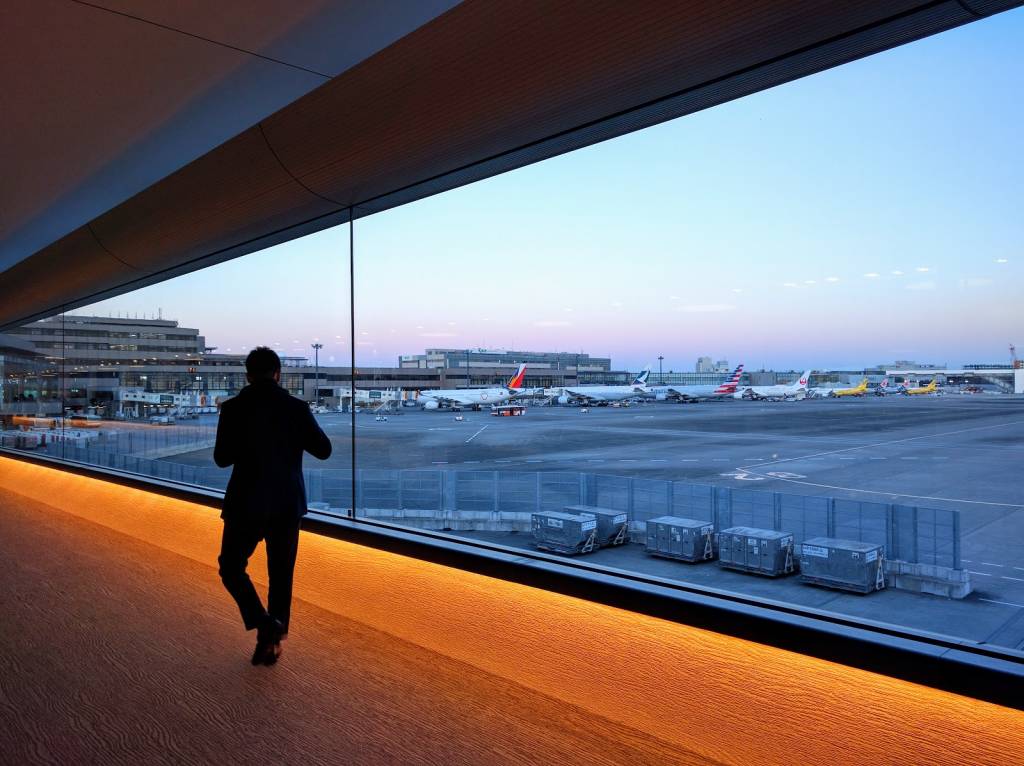
Finding the Best Transport From Narita Airport to Tokyo
How to get from the plane to your accommodation.

New Video: Top Japanese Phrases You Need Before Traveling to Japan

5 Stunning Spring Bus Tours From Tokyo
Take a ride to experience the best of the season.

Top 25 Easy Day Trips From Tokyo
Add a few of these to the wander list.

Tokyo to Osaka: Fast and Creative Ways of Getting There
Full guide to taking the bullet train, buses, and low-cost flights.

New Video! Suica Card in 2024: How and Where to Buy
We cover where and how to purchase Suica cards, digital Suica, Welcome Suica, and Pasmo Passport.

Close without accepting
TOKYO TO KYOTO TRAIN
Tokyo to kyoto bullet train facts, tokyo to kyoto shinkansen.
Incredible Japan is worth admiring its beauty. And taking a bullet train is one of the best ways to see astonishing landscapes on the way to your destination. Enjoy a perfect travel experience onboard a modern Nozomi Tokyo to Kyoto bullet train.
Shinkansen Tokyo to Kyoto trains provide passengers with everything they might need during the trip. There are several travel classes to choose from, offering comfortable seats and spacious legroom, as well as big luggage space to make your trip as comfortable as possible. A broad schedule with up to 31 departures allows you to adjust your trip to your plans easily and worry-free.

Book Train Tickets from Tokyo to Kyoto
What to know about tokyo - kyoto shinkansen.
Tokyo to Kyoto tours

From temples to tempura, onsens to okonomiyaki and skyscrapers to sake, join us for the ultimate Japan adventure.
On a journey from the bright neon lights of Tokyo to the cultural capital of Kyoto, you’ll see the best Japan has to offer – including the highlights and the hidden gems. Our Japan trips offer something for everyone, whether you’re a family or a foodie , a nature lover or a city slicker. Slurp ramen and learn how to roll sushi like a pro in Tokyo, relax and unwind in a steamy onsen in Hakone, catch a glimpse of an elegantly-attired geisha in Kyoto or experience the peaceful energy of Hiroshima—all while mixing with locals and experiencing the real Japan.
Tokyo to Kyoto trips
Tokyo to kyoto highlights.
Filter by rating
Frequently asked questions
Do i need a covid-19 vaccine to join an intrepid trip.
Trips from 1 January 2023 onwards
From 1 January 2023, Intrepid will no longer require travelers to provide proof of vaccination against COVID-19 (excluding all Polar trips and select adventure cruises).
However, we continue to strongly recommend that all Intrepid travelers and leaders get vaccinated to protect themselves and others.
Specific proof of testing or vaccination may still be required by your destination or airline. Please ensure you check travel and entry requirements carefully.
When is the best time to travel to Japan?
There’s never a bad time to travel to Japan but the months that see the most travellers are March, April, and May as the weather is mild and the cherry blossoms are in full bloom. The warm weather (with low humidity levels) of September, October, and November are also suitable months to visit Japan – you’ll even be treated to landscapes colored with oranges, reds, and browns for fall. While winter can be cold, this is the best time for snow activities such as skiing, snowboarding, and snow festivals. On the other hand, the summer months see high humidity levels that can leave some travelers uncomfortable.
Do I need a visa to travel to Japan?
Under current restrictions, a visa is required to enter Japan as a tourist. We recommend you apply for your visa no later than one month before your departure date. Please contact your local consulate or embassy for more information.
This page is for general information only and may be subject to change. It is your responsibility to obtain relevant visa and travel information required for entry, departure and travel to each country or region you visit on your trip. You should confirm these with the relevant embassies and/or consulates.
Last updated: 15 June, 2023
Do I need to purchase travel insurance before traveling?
Absolutely. All passengers traveling with Intrepid are required to purchase travel insurance before the start of their trip. Your travel insurance details will be recorded by your leader on the first day of the trip. Due to the varying nature, availability and cost of health care around the world, travel insurance is very much an essential and necessary part of every journey.
For more information on insurance, please go to: Travel Insurance
What are the top things to do and see in Tokyo and Kyoto?
Tokyo and Kyoto are two of Japan's most popular destinations, and for good reason! But just because they're popular doesn't mean there aren't any hidden gems to discover – especially with a local leader by your side. Below are some of our top picks of what to see and do in these bustling cities.
Hit up a karaoke bar in Tokyo
Sample sushi at Tsukiji Outer Market
Take a walk down the eclectic alleyways of Omoide Yokocho (Memory Lane)
Visit Senso-ji – the city’s oldest temple
Relax on a short cruise down the Sumida River
Discover quirky fashion and pop culture in Harajuku
Find your inner zen at Meiji Jingu Shrine
Discover Kinkakuji Temple (Golden Pavillion)
Admire the flora in Kyoto's Botanical Gardens
Explore Nijo-jo Castle
Visit the stunning Shimogamo Shrine
Learn about geisha culture in Gion District
Pick up a bargain in Nishiki-Koji Market
Walk among giant bamboo in Arashiyama Forest
Is Japan safe for LGBTQIA+ travelers?
LGBTQIA+ travelers shouldn’t have any issues visiting Japan with violence, outright hostility or overt discrimination extremely rare. However, Japan’s older generation still holds conservative values when it comes to LGBTQIA+ sexuality and non-binary gender expression, especially those that live in regional areas.
Same-sex relationships are considered legal in some districts (such as Tokyo); however, same-sex marriage hasn’t been legalized yet. Public displays of affection are often frowned upon, regardless of sex, gender, or sexual orientation so keep that in mind when you’re out in public.
For more detailed and up-to-date advice, we recommend visiting Equaldex or ILGA before you travel.
Get inspired on The Good Times
The naked truth: a non-nudist’s guide to using a Japanese onsen
Things to do in Japan during summer
What to expect in a traditional Japanese ryokan
What to expect on a Real Food Adventure around Japan
Vegetarian or vegan? Here’s how to eat your way around Japan
Here comes the sun: Your guide to Japan’s best (secret) sunrise spots
What to see, eat, drink and do in Kyoto, Japan’s most beautiful city
9 local markets every traveller should experience
- Car Rentals
- Airport Transfers
- Attractions & Tours
- Bundle & Save
- Destinations
- Trip.com Rewards
Tokyo & Kyoto in 5 Days: A Cultural Odyssey

April 18, 2024 · 3 min read

Embark on a 5-day cultural odyssey through the heart of Japan, exploring the historic streets of Kyoto and the vibrant cityscape of Tokyo. Begin your journey in Kyoto's Gion district, where traditional wooden machiya houses line the streets. Spend 2 hours soaking in the atmosphere before heading to the Yasaka-jinja Shrine, a spiritual haven for another hour. Wander through the charming lanes of Sannenzaka & Ninenzaka, and marvel at the architectural splendor of Kiyomizu-dera Temple. On day two, ascend the vermilion torii gates at Fushimi Inari Taisha, then indulge in local flavors at Nishiki Market. Nijō Castle's grandeur awaits you with its rich history and World Cultural Heritage status. Day three introduces the golden pavilion of Kinkaku-ji, the tranquil rock gardens of Ryōan-ji, and a picturesque journey aboard the Arashiyama Sagano Romantic Train. Transition to the bustling energy of Tokyo on day four, immersing yourself in the dynamic Shinjuku City and finding peace within the lush Shinjuku Gyoen National Garden. Your final day is a tech enthusiast's dream in Akihabara Electric Town, followed by the historic Sensō-ji temple and panoramic views from Tokyo Skytree. This itinerary promises a blend of tradition and modernity, ensuring an unforgettable experience in Japan.
- Day 1: Exploring the Timeless Charm of Kyoto's Gion and Historic Temples

Begin your Kyoto adventure by stepping into the historical district of Gion, known for its traditional wooden machiya houses and the exclusive teahouses where geiko and maiko entertain. As you wander through Gion's atmospheric streets, immerse yourself in the culture and history that permeate the air. This characteristic neighborhood, with its well-preserved architecture and ambiance, offers a glimpse into the Kyoto of old, making it a perfect introduction to the city's storied past.
Attraction Info
- Gion, Higashiyama Ward, Kyoto, Japan
- Suggested tour duration: 2 hour
Recommended Nearby Restaurants
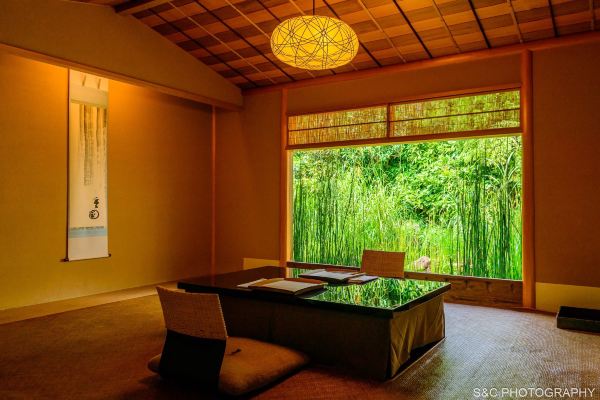
Yasaka-jinja Shrine
Just a short stroll from the enchanting streets of Gion lies the Yasaka-jinja Shrine, a spiritual cornerstone of Kyoto. This Shinto shrine, also known as Gion Shrine, is famous for its role in the Gion Matsuri, one of Japan's most renowned festivals. With its vibrant lanterns and serene atmosphere, the shrine provides a peaceful retreat and a chance to reflect amidst the bustling city. Spend an hour here to soak in the tranquility and admire the traditional architecture.
- 625 Gionmachi Kitagawa, Higashiyama Ward, Kyoto, 605-0073, Japan
- Suggested tour duration: 1-2 hour
- Open 24 hours
Sannenzaka & Ninenzaka
Continue your cultural journey to the picturesque lanes of Sannenzaka & Ninenzaka. These charming stone-paved streets, lined with quaint shops and inviting tea houses, are perfect for a leisurely exploration. As you meander through this historic area, you'll feel as though you've stepped back in time. The preservation of these neighborhoods allows you to experience the Kyoto of yesteryears, complete with the warmth and hospitality of its local artisans and shopkeepers.
- 2-chome, Masuya-cho, Higashiyama-ku, Kyoto 605-0826, Kyoto Prefecture
- Suggested tour duration: 1 hour
Kiyomizu-dera Temple
Conclude your day with a visit to the iconic Kiyomizu-dera Temple, a UNESCO World Heritage site that offers breathtaking views of Kyoto. The temple's veranda, jutting out from the hillside, provides a panoramic vista that is especially stunning during cherry blossom season or when the autumn leaves are ablaze with color. The temple's history, dating back to 780 AD, and its connection to the pure waters of the Otowa Waterfall make it a spiritual and historical treasure not to be missed.
- 1-294, Kiyomizu, Higashiyama-ku, Kyoto-shi, Kyoto, 605-0862, Japan
- Open from 01/01-03/22,6:00am-6:00pm;Open from 03/23-03/31,6:00am-9:30pm;Open from 04/01-06/30,6:00am-6:00pm;Open from 07/01-08/13,6:00am-6:30pm;Open from 08/14-08/16,6:00am-9:30pm;Open from 08/17-08/31,6:00am-6:30pm;Open from 09/01-11/17,6:00am-6:00pm;Open from 11/18-11/30,6:00am-9:30pm;Open from 12/01-12/31,6:00am-6:00pm
Where to Stay Tonight
Kiyomizu sannenzaka home in kyoto, kiyomizu sannenzaka.
- Day 2: Kyoto's Cultural Treasures and Culinary Delights
Fushimi Inari Taisha
Begin your second day in Kyoto with a spiritual start at Fushimi Inari Taisha, the head shrine of the god Inari, located at the base of a mountain also named Inari. Spend a couple of hours wandering through the thousands of vermilion torii gates that trail into the wooded forest of the sacred Mount Inari. This iconic site offers not only a mesmerizing walk through the gates, known as Senbon Torii, but also provides a glimpse into Shinto traditions and the opportunity to enjoy breathtaking views of Kyoto from the summit.
- 68 Fukakusa Yabunouchicho, Fushimi-ku, Kyoto, Kyoto Prefecture
- Suggested tour duration: 2-3 hour

Nishiki Market
After soaking in the tranquility of Fushimi Inari Taisha, make your way to the bustling Nishiki Market, a haven for food lovers. Known as 'Kyoto's Kitchen,' this narrow, five-block long shopping street is lined with more than one hundred shops and restaurants. With a history dating back several centuries, the market is the perfect spot to sample local specialties, such as pickled vegetables, fresh seafood, and Kyoto's distinctive sweets. Allow yourself to be tempted by the sights, sounds, and smells in this lively culinary heart of Kyoto.
- 609番地 Nishidaimonjichō, Nakagyo Ward, Kyoto, 604-8054, Japan
Nijō Castle
Conclude your day's exploration at Nijō Castle, a UNESCO World Heritage site that once served as the Kyoto residence of the Tokugawa Shogunate. With one hour to traverse its historical grounds, you'll marvel at the castle's ornate architecture, including its impressive gates and stone walls, surrounded by moats. Inside, the Ninomaru Palace is adorned with lavish paintings and carvings, while the 'nightingale floors' ingeniously chirp underfoot, designed to alert occupants of any intruders. The castle's expansive gardens are equally impressive, offering a serene setting to reflect on the day's journey through Kyoto's rich history.
- 541 Nijōjōchō, Nakagyo Ward, Kyoto, 604-8301, Japan
- Open from 8:45am-5:00pm,Castle closed days: December 29th to 31st at the end of the year. The specific business status is subject to the opening conditions on that day.
Toki No Yado Nijo
- Day 3: Temples and Trains - Kyoto's Cultural and Scenic Journey
As the sun climbs higher on our third day, we begin with a serene visit to Kinkaku-ji, Kyoto's golden pavilion that shimmers against the morning light. This Zen temple, adorned with gold leaf, reflects elegantly on its surrounding pond, creating a picture-perfect moment for any visitor. Spend an hour wandering the meticulously maintained gardens and soaking in the tranquil atmosphere of one of Kyoto's most iconic landmarks.
- 1 Kinkakujichō, Kita Ward, Kyoto, 603-8361, Japan
- Open from 9:00am-5:00pm

Continuing our temple trail, we delve deeper into Kyoto's spiritual heritage with a two-hour stay at Ryōan-ji, famous for its enigmatic rock garden. The simplicity of the stones set against raked gravel invites contemplation and calm, a stark contrast to the bustling city life. The temple grounds also boast a serene pond and lush greenery, offering a peaceful retreat to reflect and rejuvenate.
- 13 Ryōanji Goryōnoshitachō, Ukyo Ward, Kyoto, 616-8001, Japan
- Open from 8:00am-5:00pm
Arashiyama Sagano Romantic Train
After immersing in the tranquility of temples, we embark on a different kind of journey aboard the Arashiyama Sagano Romantic Train. This one-hour scenic ride takes you through the picturesque landscapes of rural Kyoto. As the train winds its way through the Hozugawa River valley, framed by seasonal beauty, be sure to capture the moments where nature's artistry and historical charm blend seamlessly, creating an unforgettable experience in the heart of Japan.
- Saga Tenryuji Kurodocho, Ukyo-ku, Kyoto City Torokko Saga Station to Torokko Kameoka Station
- Open from 9:02am-7:45pm,Train departure schedule is subject to change, please refer to the actual situation on site The official schedule: https://www.sagano-kanko.co.jp/jikoku.php

Hotel Binario Saga Arashiyama
Guest house atagoya.
- Day 4: Exploring the Vibrant Heart of Tokyo
Shinjuku City
Kickstart your fourth day by immersing yourself in the bustling energy of Shinjuku City, Tokyo's renowned district known for its dynamic urban atmosphere. As the sun rises, the streets of Shinjuku come alive, offering a full day's adventure amidst skyscrapers, shopping centers, and an array of dining options. This characteristic neighborhood is a microcosm of Tokyo's fast-paced culture and modernity, promising an unforgettable urban experience.
- Tokyo, Japan
- Suggested tour duration: 0.5-1 day

Shinjuku Gyoen National Garden
After the exhilarating buzz of Shinjuku City, find solace in the tranquil beauty of Shinjuku Gyoen National Garden. A mere stone's throw away, this sprawling oasis offers a serene retreat with its meticulously landscaped gardens blending Japanese, English, and French garden designs. Spend a couple of hours wandering through the lush greenery, beside the tranquil ponds, and under the shade of cherry blossoms, providing a picturesque contrast to the morning's metropolitan vibe.
- 11 Naitōmachi, Shinjuku City, Tokyo 160-0014, Japan
- Open from 10/1-3/14,Tue-Sun,9:00am-4:30pm;Open from 3/15-6/30,Tue-Sun,9:00am-6:00pm;Open from 7/1-8/20,Tue-Sun,9:00am-7:00pm;Open from 8/21-9/30,Tue-Sun,9:00am-6:00pm;Closed on Mon,*The park is open every Monday from March 25 to April 24 and November 1 to 15; Rest days: year-end and New Year holidays (December 29th to January 3rd).
Book Tea Bed Shinjuku-Gyoen
Toyoko inn tokyo shinjuku gyoemmae eki 3 ban deguchi.
- Day 5: Tokyo's Techno Vibes and Towering Views
Akihabara Electric Town
Begin your final day in Tokyo with a visit to the iconic Akihabara Electric Town, a buzzing hub that's a must-see for tech enthusiasts and pop culture aficionados alike. As you wander through Akihabara's vibrant streets, you'll be enveloped in a world where the latest gadgets, anime merchandise, and electronic wonders reign supreme. Dedicate your day to exploring the endless rows of shops and experience the unique otaku culture that has put Akihabara on the map.
- 1 Chome-12 Sotokanda, Chiyoda City, Tokyo 101-0021, Japan

After immersing yourself in modern marvels, step back in time with a visit to Sensō-ji, Tokyo's oldest and most significant temple. This historic monument, just a short journey from Akihabara, offers a serene contrast to the morning's high-energy exploration. Spend an hour marveling at the temple's grand architecture, the majestic Thunder Gate, and the vibrant shopping street of Nakamise, where traditional souvenirs and snacks provide a taste of old Tokyo.
- 2-chōme-3-1 Asakusa, Taito City, Tokyo 111-0032, Japan
- Open from 4/1-9/30,6:00am-5:00pm;Open from 10/1-3/31,6:30am-5:00pm

Tokyo Skytree
Conclude your Tokyo adventure on a high note with a trip to the Tokyo Skytree. As the day winds down, ascend to the observation decks of this towering structure, the tallest in Japan, and be rewarded with breathtaking panoramic views of the sprawling city below. Reflect on your journey as you gaze out over the skyline, spotting landmarks and the distant mountains, a fitting finale to your unforgettable five-day exploration of Tokyo and Kyoto.
- 1 Chome-1-2 Oshiage, Sumida City, Tokyo 131-0045, Japan
- Open from 04/01-04/06,10:00am-10:00pm;Open from 04/08-04/13,10:00am-10:00pm;Open from 04/16-04/20,10:00am-10:00pm;Open from 04/22-04/27,10:00am-10:00pm;Open from 05/07-05/11,10:00am-10:00pm;Open from 05/13-05/14,10:00am-10:00pm;Open from 05/16-05/18,10:00am-10:00pm;Open from 05/20-05/25,10:00am-10:00pm;Open from 05/27-05/31,10:00am-10:00pm;Open 10:00am-9:00pm on 04/15;Open 10:00am-9:00pm on 05/15;Open 9:00am-10:00pm on 04/07;Open 9:00am-10:00pm on 04/14;Open 9:00am-10:00pm on 04/21;Open from 04/28-05/02,9:00am-10:00pm;Open 9:00am-10:00pm on 05/12;Open 9:00am-10:00pm on 05/19;Open 9:00am-10:00pm on 05/26;Open from 05/03-05/06,8:00am-10:00pm,Last admission for the TOKYO SKYTREE Tembo Deck is 8 p.m. for the TOKYO SKYTREE Tembo Galleria is 8:30 p.m
Hotel Livemax Asakusa Sky Front
Entire typical japanese house1min walk to skytree.
* All user reviews in this article have been translated by machine.
* The information above is subject to change at any time. For the latest information, please check the websites of hotels and attractions.

<h3>Trending Searches</h3>
Popular Content
- Jurien Bay 1 Day Itinerary
- Kuching Division 2 Days Itinerary
- Weihai 1 Day Itinerary
- Milan Turin 2 Days Itinerary
- Sydney 5 Days Itinerary
- Dubrovnik Zagreb 3 Days Itinerary
- Nanjing Lianyungang 2 Days Itinerary
- Shanghai Jiaxing 6 Days Itinerary
- Zhoushan 4 Days Itinerary
- New Taipei City 2 Days Itinerary
- Izumisano 1 Day Itinerary
- La Digue 1 Day Itinerary
- Balatonfuredi 1 Day Itinerary
- Wanning Sanya 6 Days Itinerary
- Tongren 1 Day Itinerary
- Yingde 2 Days Itinerary
- Yantai 1 Day Itinerary
- Xiapu Fuzhou 3 Days Itinerary
- Yichang 6 Days Itinerary
- Phuket Phi Phi Islands 5 Days Itinerary
- Customer Support
- Service Guarantee
- More Service Info
- Website Feedback
- About Trip.com
- Terms & Conditions
- Privacy Statement
- About Trip.com Group
Other Services
- Investor Relations
- Affiliate Program
- List My Property
- Become a Supplier
What is the Best Way to Do 1 Day Trip to Kyoto from Tokyo?
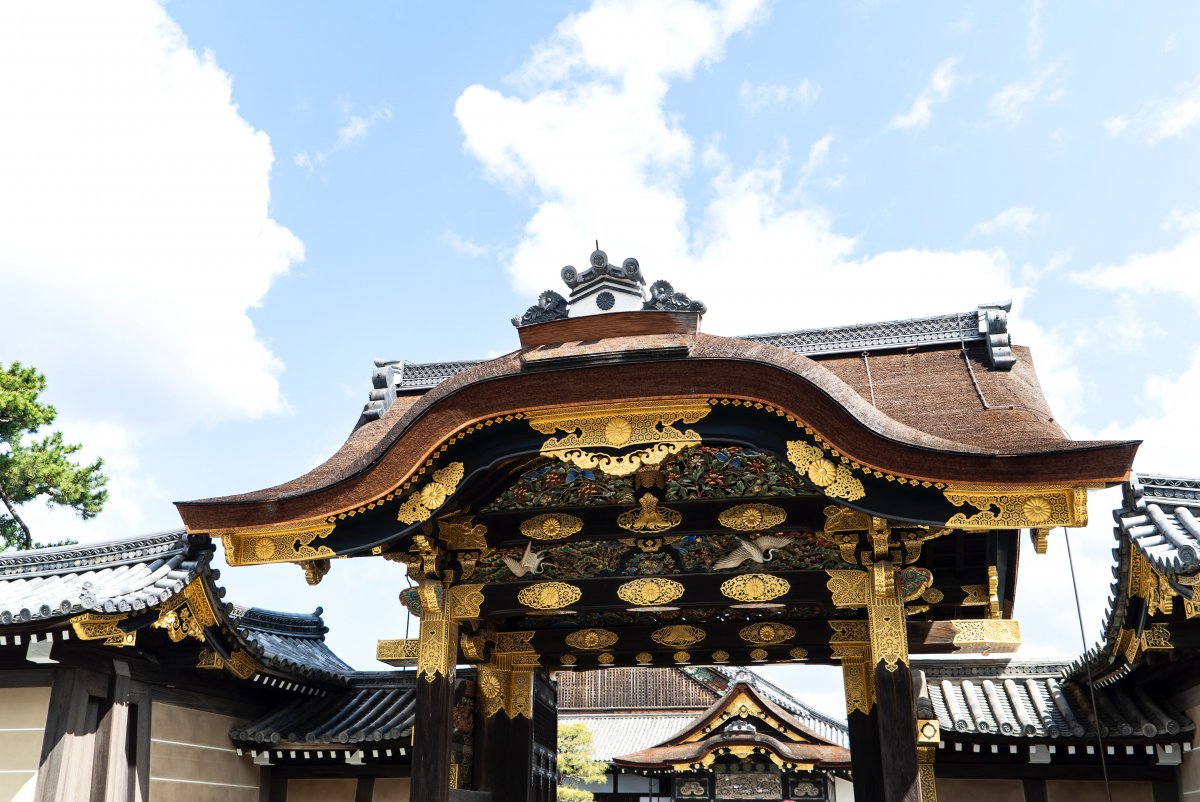
How far is Kyoto from Tokyo?
Private tours in kyoto from tokyo, shinkansen bullet train: fastest and comfortable, bus: cheapest, 1. comfortable plan: bullet train round-trip, 2. make the most out of your day: go by bullet train and return by night bus, 3. budget plan: round-trip by night bus, comparative table, you may also like the following articles.
Tokyo and Kyoto are the two most famous cities in Japan, and many tourists visit both cities. Even if you visit only Tokyo for a short period of time, it is still possible to visit Kyoto from Tokyo. In fact, if you have the time we recommend you to visit Kyoto. Even if you go there for one day, it will enrich your experience of Japan.
Kyoto is 2-3 hours away from Tokyo by Shinkansen, the actual time depends on which Shinkansen you take. It takes about 5-7 hours if you travel by bus or car and there are overnight buses as one of the options too. If you want to travel in the cheap way, you can get on the night bus around midnight and you will get to Kyoto early in the morning! Kyoto and Tokyo are very different cities and with visiting them both you will experience Japan ‘one step deeper’. You might not have thought of it, but you can even visit Kyoto from Tokyo for one day.
The easiest way for you would be our day-trip tour from Tokyo to Kyoto. This full-day guided tour allows you to see the best highlights of Kyoto in one day including Kinkakuji Temple (the Golden Pavilion), Fushimi Inari Taisha and Kiyomizudera Temple. The only thing you have to do is get to Kyoto yourself, which we can also arrange for you. But when you have a JR Pass, like many tourist have the Shinkansen in included. Check the link below for more details about the guided day-trip tour to Kyoto from Tokyo!
Kyoto 1–Day Private Walking Tour from Tokyo (8 Hours Tour in Kyoto)
Transportation to Kyoto
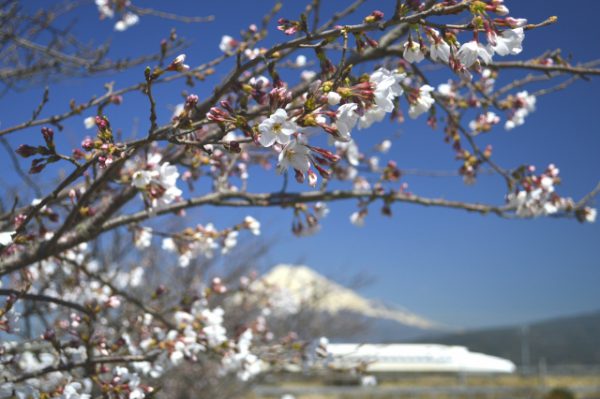
There are two options for transportation to get to Kyoto from Tokyo. 1. Shinkansen Bullet Train 2. Night Bus Let’s check out pros and cons of each one.
The fastest way to travel to Kyoto from Tokyo is by Shinkansen. The fastest Shinkansen called Nozomi takes about 2,5 hrs and costs ¥13.080 per person for one way. The Nozomi, however, is not covered by the JR Rail Pass. When you have JR Pass, it is better to take the second fastest Shinkansen Hikari . Hikari will get to to Kyoto in about 3 hrs with no extra charge! You can either board the Shinkansen at Tokyo station or Shinawaga station.
Our tips for the Bullet Train ride:
- From Tokyo to Kyoto: Reserve the seat E because you can see Mt. Fuji from the seat window on a sunny day. Mt. Fuji appears 40 mins after the departure of Tokyo.
- Tokyo station: Buy a Bento lunch box. There is a great variety of unique lunch boxes sold here and you can enjoy them during Shinkansen ride!
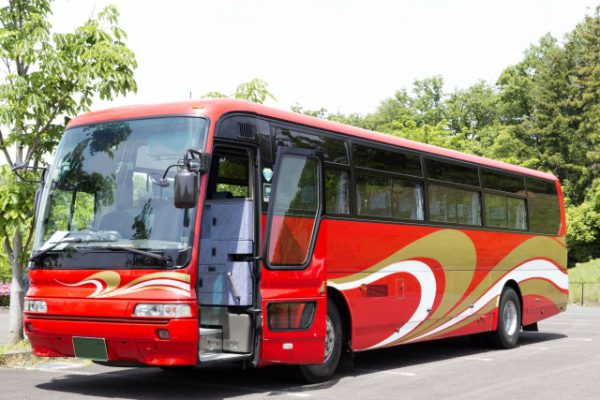
The cheaper way is taking a bus, especially the overnight bus. If you take a night bus, departure time from Tokyo is around 10-11pm, then arriving time in Kyoto is 6-7am.
The price varies on days. It costs usually between ¥1.700 and ¥6.000. The price may be higher on weekends and during the holiday season of Japan.
Recommended bus companies: ・ Willer Express ¥4.000 ・ VIP liner ¥4.000 ・ Sakura Kanko bus ¥1.700
Recommended itinerary for a day-trip to Kyoto from Tokyo
Transportation fee: approx. ¥ 26.000
08:00 – 11:00 Bullet train from Tokyo to Kyoto 11:00 – 18:00 Sightseeing in Kyoto for 7 hours – (Please check Kyoto itinerary here .) 18:00 – 21:00 Bullet train from Kyoto to Tokyo
Recommended hotels close to Tokyo station (Luxe and First Class)
The Tokyo Station Hotel Four Seasons Hotel Tokyo at Marunouchi Shangri-La Hotel, Tokyo
Transportation fee: approx. ¥ 15.000 – ¥ 20.000
08:00 – 11:00 Bullet train from Tokyo to Kyoto 11:00 – 08:00 Sightseeing in Kyoto for 7 hours – (Please check Kyoto itinerary here ) 18:00 – 22:00 Enjoy dinner and night activity in Kyoto 23:00 – 06:30 Back to Tokyo by night bus
Recommended budget hotels in Akihabara station – easy access to Tokyo station’s bus terminal.
GRIDS AKIHABARA First Cabin Akihabara Glansit Akihabara
Transportation fee: approx. ¥ 4.000 – ¥ 12.000
23:00 – 06:30 Go to Kyoto by night bus 06:30 – 08:00 Arrive in Kyoto and have breakfast 08:00 – 18:00 Sightseeing in Kyoto for 10 hours – ( Kyoto one day itinerary ) 18:00 – 22:00 Enjoy dinner and night activity in Kyoto 23:00 – 06:30 Back to Tokyo by night bus
To get most out of your visit to Kyoto, we recommend you to take a guided tour so you can see around Kyoto efficiently, especially when you are there for a short time! The local guide will tell you more about the history and culture of Kyoto. We offer many different tours in Kyoto, below the two most popular, please check them out!
Food Tour: Kyoto FooDrink Tour – Nishiki Street & Gion Private Tour: Kyoto 4 Hour HIGHLIGHT Private Walking Tour
What is your preferred mode of traveling? If you have your JR Rail Pass, the Shinkansen will probably be your best option – it is already included in the price. Otherwise the (much) cheaper night bus is a great alternative. Recently is has become much more comfortable than before so it is definitely a great option to go to Kyoto!
Is it hard to come to Japan right now? You can join our tour at home and learn about Kyoto before you come to Japan! Explore 5 spots including Kinkakuji, Arashiyama, Fushimi Inari etc. while the local guide telling you the small story about the area. Kyoto Virtual Highlight Tour
If you want some advice, please feel free to ask us Contact Japan Wonder Travel
Follow us on Instagram or Facebook for more travel inspiration. Or tag us to get featured!
Happy travelling!

This post may contain some affiliate links. When you click through and make a purchase we may receive some commission, at no extra costs to you .

Hi there! Thank you for the tip on this page! May I please ask if it’s advisable to take the Hikari there and back? And by what time should we take the Hikari at night?
Hi Vivian-san, Thank you for your inquiry. Of course you could use Hikari between Tokyo and Kyoto. You could use Hikari with JR rail pass. Then last train is about 8pm between Tokyo and Kyoto.(It takes about 3 hours.) If you have any question, please feel free to let us know.
Best regards, Yu
Hi.. in regards to the bus.. is it safe for non- Japanese speaking passengers? Is it comfortable? How do I get more details on the bus? I’m flying in to Haneda.. how do I go by bus from there?
Hi Husna-san, Yes it’s safe for non-Japanese speaking passengers. I used bus last month, some non Japanese speaking passengers were in bus. 3 seat-row is comfortable, 4 seat-row is bit tight, I think.
Please check bus’s company page. From airport, there is an airport limousine bus to Shinjuku bus terminal.
hello, is the bus travel from tokyo to kyoto at night, safe?
I often use bus and it’s always safe basically.
Hello! Would it be worth buying a JR pass just for this one day trip, as I am based in Tokyo and will only do one trip outside of Tokyo due to time. I’ve heard a return trip on the bullet train is as expensive as a JR Pass.
Don’t use the night bus if you’re claustrophobic, afraid of the dark, or need to look out of the window when you travel. The entire seated area is boxed off with curtains (you can’t see out of the windshield in front either), lights are not allowed, opening the curtains is not allowed. It’s supposed to create a relaxed environment but there’s nothing much relaxed about it. They’ve been pretty strict when I’ve tried to see where I’m going.
Thanks for your article! We will take the night bus from Kyoto to Tokyo, arriving around 7:00 in the morning. But the hotel does not accept baggage deposit and we can not check in before 15:00. Are there places where we can “crash” with our luggages and wait/rest a bit until we can check in?
What “crash” means? There are baggage storage services in hub station like Tokyo station. If you are tired and would like to have rest, there are many manga-cafe which have lots of comics. https://www.japan-guide.com/e/e2025_manga_kissa.html
The time is limited. So we recommend you leave baggage at storage service and explore the big city TOKYO.
Hi, of using bus, do you think 1 full day (10 hrs) is enough to tour Kyoto and Nara including travel time in between? What’s the travel duration? Thanks!
@Leah-san, Thank you for your comment. From Kyoto to Nara it takes about 1 hour. And you should spend at least 4 hours in Nara. We think it’s not enough for 10 hours in Kyoto and Nara. If you only have 10 hours, you should spend only in Kyoto!! Have a nice trip!!
Hello! What do you mean by “no extra charges” with the Hikari train if we use a JR Pass? Does it mean once we purchase a JR Pass, we are able to go inside the train instantly without paying? May I also ask how much the discounts are from Kyoto to Tokyo if we have the Pass? Thank you!
If you have JR pass, you take Hikari train free. If you would like to take Nozomi train, you need to pay extra. Please check http://www.japanrailpass.net/
hi, i will be arriving in Narita airport Tokyo on May 24 at 5pm, i want to go to Kyoto right away overnight bus. How can i get to the Will Express station from the airport?
Hello Arcadio Elegado-san,
Thank you for your comment. What’s “the Will Express Station”? Willer Express bus station in Shinjuku?
You need take NEX(Narita Express: JR train) or Air Port Limousine bus from Narita to Shinjuku station.
Is it possible to buy a return ticket for the bulletin train to Kyoto, or do you purchase two separate tickets for Tokyo-Kyoto Kyoto-Tokyo?
You will need to buy two one-way tickets for the Shinkansen. Let us know if you have more questions, happy to help! Enjoy your trip!
- Popular destinations
- Hidden places in Japan
- Tours and workshop
- Food and drink in Japan
- Itinerary in Japan
- Places to visit in Tokyo
- Food and drink in Tokyo
- Seasonal events
- Tours & workshops
- Tokyo This Week
- Day trip from Tokyo
- Itinerary in Tokyo
- Places to visit in Kyoto
- Food and drink in Kyoto
- Itinerary in Kyoto
- Day trip from Kyoto
- Travel tips
- Accommodation
- Cultural tips
- Transportation
- Tokyo Tours
- Kyoto Tours
- Kimono Rental
- Fukushima Tours
- Mount Fuji Tours
- Tour Package
- Media Kit(English/日本語)
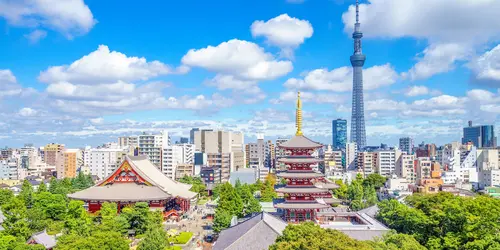
Senso-ji temple in Asakusa with Tokyo Sky Tree behind, a must-see on your first days to visit Tokyo
©Chan Richie/123RF
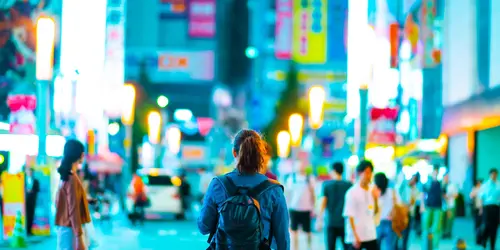
Solo woman in Shinjuku, Tokyo
©Jezael Melgoza/Unsplash
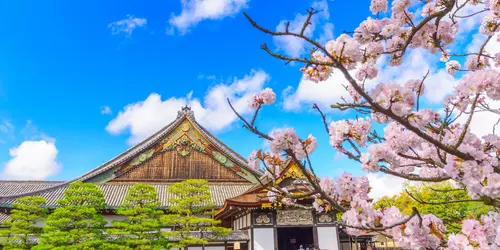
Nijo castle is a very unique castle worth visiting during your stay in Kyoto
©Sean Pavone/123RF
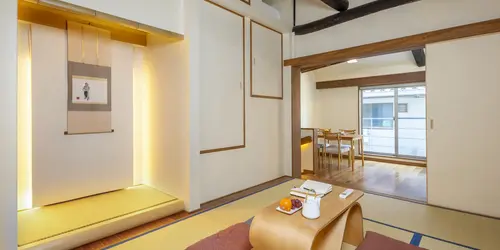
An authentic stay in one of our traditional houses in Kyoto
©JapanExperience
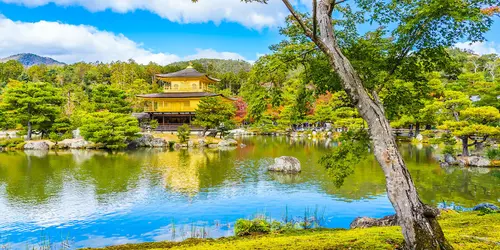
Golden Pavilion Kinkaku-ji : a must-see in Kyoto ancient capital
©siraphol/123RF
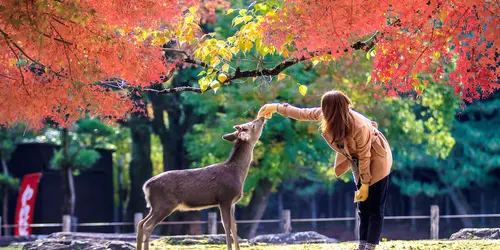
Nara Sika deers are sacred, and protected as National Treasures.
©nicholashan/123RF
- Travel insurance
- Japan Experience
Tokyo & Kyoto
- Duration : 9 days
- Locations : Tokyo,Kyoto
- Add to favorites
This tour in Japan allows you to visit Japan's two must-see cities , Tokyo and Kyoto, in a single trip.
With this package, enjoy an "affordable" trip to Tokyo, the many-sided capital, and Kyoto, the heart of traditional Japan!
Accommodation , transport pass, Shinkansen ticket, and a visit to each city are included in this trip.
9 day itinerary in Tokyo and Kyoto
- Departure city/airport : Tokyo (Narita : NRT or Haneda : HND )
- Tokyo (4 nights)
- Kyoto (4 nights)
- End Return airport : Osaka (Kansai international airport : KIX )
Please find below the itinerary details.
Tour length : 8 nights / 9 days (+ 1 day at the beginning if you leave from Europe)
Indeed, the tour departure and end dates presented on this page relate to your stay in Japan. On departure, you will have to leave Europe on the day before. The return flight is on the same day due to the time difference.
Example :
- Departure from Europe : January 1st
- Arrival Tokyo (date to be selected in the tour calendar while booking ) : January 2nd
- Return flight from Kansai international airport : January 10th
Like this tour but want to add a night at Mount Fuji? Take a look at our other tour " Tokyo, Mount Fuji, Kyoto ".
Like this tour but want to add a night at Mount Fuji and also visit Hiroshima? Then " Classic Japan " is the tour for you !
Why this trip to Japan ?
- Welcomed at the airport by our team, you will be taken to Tokyo by shuttle bus
- Settle in the heart of Tokyo in your 3* hotel chosen for its comfort and location
- With your tickets, climb to the top of the Tokyo Sky Tree , 634m high.
- Head for Kyoto by high-speed Shinkansen
- In Kyoto, a travel angel will welcome you to a traditional Japan Experience house
- At nightfall, a guided tour of the traditional geisha quarter awaits you
- Take advantage of unlimited transport to visit Tokyo, Kyoto and its region
- Enjoy unlimited internet access thanks to your pocket Wi-Fi
- If needed, contact our bilingual Japanese/English-speaking assistance team available 7/7
- A number of guided days or other optional activities are available
- On the final day, a shuttle bus will take you from your accommodation to the airport
- Benefit from the expertise of Japan Experience , European leading travel agency in Japan.
Most recent customer reviews about this trip
"We are in Japan and having a marvelous time! I am so happy we used your company to help us while we were in Tokyo. Everything you provided was perfect. The agent who met us at the airport was lovely and, after 25 hrs of travel, we were grateful for the comfortable and safe drive to the hotel. The hotel accommodations were exactly what we needed and we very much enjoyed our stay. However, the best part of our stay in Tokyo was definitely our guide who we booked as an option. She was exceptional! We were able to see so much in a relatively short period of time, none of which would have been possible on our own. She was totally knowledgeable and her personality was delightful. It was like having a good friend show us around Tokyo. I’m so glad we spent the day together." (G.D, US, November 2022)
Your trip to Tokyo and Kyoto in detail
Day 1 : wake up in tokyo 東京.
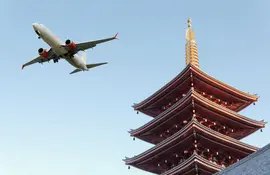
Arrival in Japan
©Vasin Leenanuruksa / 123RF
Arrival at Tokyo airport (Narita or Haneda). Welcome to Japan! Yokoso 日本へようこそ!
Welcomed out of customs by our airport assistant, who will give you all your travel documents and Pocket WiFi. Unaccompanied transfer from the airport to Tokyo (see details).
This transfer is done in a shared shuttle or bus, with other guests departing for the same hotel or a hotel close to yours. These transfers depart between 1.5 and 3 hours after your scheduled flight arrival and stops can be made before your hotel.
If you would like a private, non-stop transfer directly after the actual arrival of your flight, feel free to take the "Private Taxi from the Airport" option.
Check-in at Hotel OMO3 Tokyo Akasaka by Hoshino Resorts or Same category hotel 3* (rooms available from 3:00pm).
Day 2 : First steps in the capital
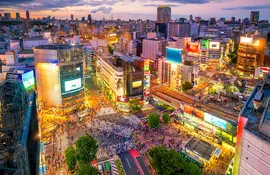
Worldwide famous Shibuya crossing, Tokyo
©Wasin Pummarin/123RF
What is there to do in Tokyo on the first day?
We advise you to slowly start visiting Tokyo from its western districts: - Harajuku: the avant-garde district - Meiji Jingû, the imperial shrine - Takeshita-Dori: the most famous street in Japan - Omotesando: Tokyo's Champs-Élysées - Shibuya and its unmistakable "crossroads"
One of our many experienced English-speaking guides can also accompany you to visit the classic sights of Tokyo (optional, from 9:00 to 17:00).
Day 3 : The big loop
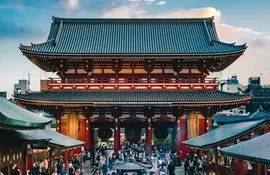
Senso-ji temple in Asakusa, Tokyo
©Moiz K. Malik/Unsplash
For this second day of visiting Tokyo, we recommend the following "loop". Start from Tokyo Central Station, with its original architecture, then go to visit: - Ginza, Tokyo's chic district - Tsukiji, the small outdoor food market - Hamarikyu, the Japanese garden between Tokyo's buildings - Asakusa, a traditional district and place of pilgrimage, accessible by a cruise on the Sumida River - Sensô-ji Buddhist temple, one of the oldest in the city - Tokyo Sky Tree reaching a height of 643m and its panoramic view of Tokyo at sunset ( ticket included in your tour )
Enjoy a cruise on the Sumida River between Hamarikyu and Asakusa.
Day 4 : Follow the guide
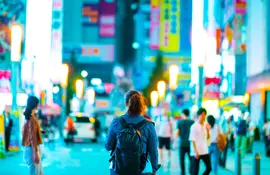
There are still many places to discover according to your taste ! Ueno, Yanaka, Odaiba...
Don't hesitate to book an English-speaking guide for the day (optional) to visit Tokyo off the beaten path!
Make the most of our many optional activities: - Are you looking more for fun? Ghibli Museum, Disneyland or Hello Kitty Park are waiting for you! - Do you prefer a t hemed activity? book a visit on an architecture tour, gardens, home cooking or Noh's theatre. - Chasing thrills? Let yourself be tempted by a helicopter ride or a sumo tournament (in season)!
Day 5 : On the way to the former capital
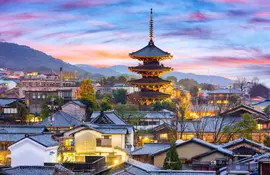
Yasaka Pagoda at night, in Gion, Kyoto old town
Head to Tokyo Station to board one of the fastest trains in the world: the Shinkansen ! Travel by Nozomi Shinkansen to Kyoto (direct, approx. 2.5 hours, tickets included). We will try to reserve seats which give a view of Mount Fuji, about 40 minutes from the start! From noon onwards, you can settle into your traditional Japan Experience house ! A Travel Angel will welcome you, show you some unique details and help you to have an unforgettable stay in Kyoto. You will be able to "live the Japanese way" for a few days, with a space much bigger than a hotel room and a kitchen to prepare good Japanese food! You have 3 days to visit Kyoto. Start in the afternoon in the historic Gion district near your accommodation : - Kiyomizu-Dera, the great water temple - the historical streets of Sannen-zaka & Ninnen-zaka - Kodai-ji, the maple and bamboo temple of Kyoto
Finish off seeing the sunset in Gion. Meet your guide at 19:00 to start your late stroll around Gion, Kyoto's historic district.
More details on the exact time and location in your travel diary. At the end of this 1 hour 30 walk, your guide will be able to advise you on the best places to eat out! Please note that it is strictly forbidden to take photographs in the historic district of Gion.
Day 6 : Gold and Silver Treasures
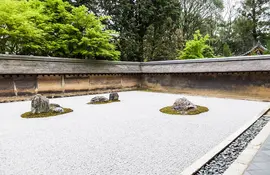
Visit Ryoan-ji, Kyoto, the most famous rock and zen garden in Japan
©Philippe Voisin
We recommend the following itinerary for this second day's visit to Kyoto: - Ryoan-ji Zen Garden - The Kinkaku-ji ( Golden Pavilion ) - Ginkaku-ji ( Silver Pavilion ) - The bewitching path of philosophy - The Nanzen-ji temple
One of our many experienced English-speaking guides can accompany you on a tour of these symbolic sites (optional, from 9:00 to 17:00).
Day 7 : Now for some activity...
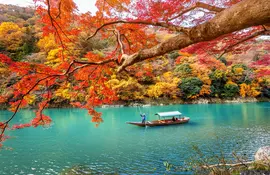
River in Arashiyama during fall : famous touristic site to visit in Kyoto
©Tawatchai Prakobkit/123RF
Continue to visit Kyoto heading west : - Nishiki, Kyoto's culinary market - Nijo castle, former residence of the shogun - Arashiyama, to visit the bamboo grove and its monkey mountain
This is your last full day to visit Kyoto, so make the most of our many optional activities: - Want to enjoy nature? Check out our cycling activities along the Kamogawa River or hiking in the Takao Gorge! - Prefer Japanese arts? tea ceremonies, meditation activities or private visits to secret gardens will seduce you. - Looking for Japanese countryside? Let yourself be tempted by a trip to Ohara, or try our flagship activity: on the Tea Road!
Day 8 : Between temples and deer
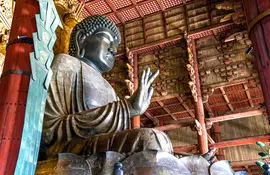
Todai-ji temple and its imposing statue of the buddha : a must-see in Nara
©Surachet Shotivaranon/123RF
For your last day, we recommend taking the 50 minute journey to Nara, which is included in your package.
Visit to Nara, the first permanent capital of Japan in the 8th century: Discover: - The Shinto shrine Kasuga Taisha and its thousands of lanterns - The Todaiji, its great bronze Buddha and the imposing Nan-Daimon gate - Kofukuji temple and its beautiful pagoda
Return to Kyoto and stop for sunset at Fushimi Inari, the huge 10,000 torii sanctuary in Kyoto. If you wish to be accompanied on this day, one of our English-speaking guides will unveil all the secrets of Japan's first capital (optional, return trip from Kyoto).
Day 9 : Sayonara, and see you next time!
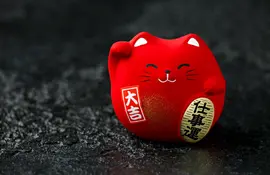
Sayonara - bye bye Japan !
©Maksims Grigorjevs/123RF
Direct transfer to Kansai International Airport (included but not accompanied).
Return flight to Europe, North America, Australia.
Do not hesitate to extend your trip by one or more days to Kansai or elsewhere... We will be able to advise you!
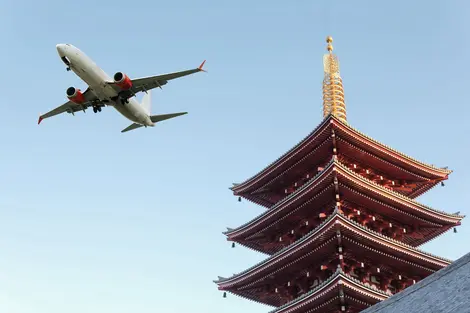
Included in your self-guided tour
Accommodation
- 4 nights in a 3* hotel in the heart of Tokyo, close to public transport
The basic rate includes a twin room for two people.
- 4 nights in a traditional Kyoto house (cleaning, bed linen/towels and tourist tax included)
- Airport transfers to Tokyo
- Return airport transfer Kyoto -> KIX
- Prepaid public transport card
- 3-day Tokyo Metro Pass
- 3-day unlimited transport pass in Kyoto and Nara (Kansai Thru Pass)
- Shinkansen Nozomi Tokyo -> Kyoto, seats reserved, standard class
Experiences
- Airport welcome
- Entrance to Tokyo Sky Tree (combined ticket 350+450m)
- Welcome to Kyoto by a travel angel
- Guided night tour of Gion (1h30)
Additional services
- Unlimited Wi-Fi access with pocket Wi-Fi
- Complete e- travel diary sent before your departure
- The helpline is available from 8am to 10pm Japanese time, 7 days a week, in English and Japanese. The number will be given to you in your travel pack. It is valid for telephone calls and Whatsapp.
Not included in the price of your trip
- Flights Europe <> Japan
- Optional insurance policies
- Personal expenses including meals (breakfast optional)
- Public transport when your transport cards have run out (see details)
- Anything not included in the "included in your tour" section
More about your trip
Your tour :
- The prices displayed on this page may vary according to the exchange rate of the Japanese ¥.
- Unfortunately, this tour is not accessible to people with reduced mobility.
- Pets are not allowed.
- Children and babies accepted. From 3 to 11 years old a child rate is offered. In each accommodation, a standard adult bed will be offered to them, and a standard seat will be allocated to them in transport. From 0 to 2 years old inclusive, a "baby" rate is offered. This price corresponds to the allocation of a cot in the majority of the accommodation of the chosen circuit. However, we cannot guarantee a baby cot in each accommodation.
- This programme is subject to change due to circumstances such as weather conditions or any other case of force majeure. Please note that due to the current circumstances, any information mentioned is subject to change or modification.
- Travel diary by email 3 weeks before departure, and other electronic documents (TokyoSkyTree e-voucher).
- Paper documents (airport transfer ticket, transportation card, Japan Rail Pass voucher) and Pocket WiFi upon arrival at the airport by our airport assistant.
- N.B.: no ticket for airport transfers to and from Kansai airport. The reservation is registered in the name of the tour reservation.
- N.B: In very rare cases, mostly in very high season, steps might be reversed. You will be informed in your mini travel-guide. Thanks for your kind understanding.
Your accommodation :
- Some hotels may ask you to pay a tourist tax on arrival. This depends on the city and even the hotel, as some do not include it in the booking price. Normally, it is 200¥/night/person (about £1.37/1.93$) but can be slightly higher in 4* hotels. It must be paid in cash at the hotel reception. For traditional Japan Experience accommodations, it is included in the initial tour price.
- Room size: in Japan, a densely populated country where everything is compact, 3-star luxury hotels are of very good quality but the rooms are often quite narrow (12 to 20m2/129 sq ft to 215 sq ft) depending on the hotel. Please note the size of the single room, between 10 and 16m2 (107sq ft and 172 fq ft). For more comfort, you can choose our luxury 4* accommodation upgrade option. (This option is only valid for the hotel in Tokyo, not for the traditional accommodation in Kyoto).
- Double room: Rooms for two people in western hotels have 2 single beds (twin rooms) by default, which can usually be joined together. As an option, you can select a double room instead of a twin if you prefer a double bed.
- Single room: People travelling alone and wishing to book a single room must pay a supplement at the time of booking. The single room supplement is compulsory for orders with an odd number of participants.
- 3-person room: If there are 3, 5 or more of you and you do not select the single supplement, a triple room will be allocated to you.
- In the case of a group order (> 5 people), it is possible, depending on hotel availability, that not all members of the group will be accommodated in the same hotel. Nevertheless, we aim to keep you close. The same goes for the traditional house in Kyoto.
- Names of the hotels : The names given on the site are for information only. In the event of unavailability, an establishment of equivalent standing will be scheduled. Hotels, corresponding to local standards, are given as an indication and may be changed on site for hotels of a similar category.
- Traditional house in Kyoto: each house has been chosen for its location (transport, shops, temples...) and thus to facilitate your stay. Most of them are either located in the historical district of Gion or on the edge of the Path of Philosophy and the Silver Temple. All lodgings have at least one Japanese tatami room and are equipped with a minimum of 3 beds, either in a single western bed (not double) or on a futon. Do not hesitate to specify in your comments that you want to sleep in a western bed.
Your transport :
- Flights are not included in this tour. Do not hesitate to contact us if you would like to include flights in your order: Flights in economy class with stopovers or direct flights, eco-premium or business air upgrades, provincial departures or abroad: we will be able to advise you.
- The tour departure and end dates presented on this page relate to your stay in Japan. You will arrive in Japan via Tokyo (Narita or Haneda airports) and depart from Kansai airport (KIX, not Itami ITM). On departure, you will have to leave the day before Europe and land at 6:30 p.m. at the most to make the most of the airport services of your circuit (reception and transfer to Tokyo). The return takes place the same day, taking into account the favorable time difference, with a minimum take-off time at 9 a.m. Please do not hesitate to consult us for any uncertainty or need for precision in the choice of international flights.
If the flights have been purchased by your care without the intervention of Japan Experience, it is necessary to send us by mail 1 month before your departure your flight information (flight number, airport, date and time of arrival) to allow us 'Organize your welcome and airport transfer.
- Airport Transfers: The shared limousine bus leaves from the airport and stops either in front of your hotel or at a stop within 1-15 minutes walk from your hotel. Our airport assistant in Tokyo will drive you to the platform to pick up the airport transfer. The transfer to the hotel is unassisted. If you wish to be accompanied from the airport to your hotel reception, please choose the option "Accompanied Airport Transfer". This transfer is done in a shared shuttle or bus, with other clients leaving for the same hotel or a hotel close to yours. These transfers leave between 1.5 and 3 hours after your flight's scheduled arrival and stops can be made before your hotel. If you would like a private, non-stop transfer directly after the actual arrival of your flight, feel free to take the "Private Taxi from the Airport" option. Please note: due to the many changes in flight schedules by the airlines, if the airline notifies you of a change in arrival time less than 72 hours before your departure, and if it exceeds 45 minutes, we cannot guarantee your airport shuttle. You will then have to take a taxi at your own expense, requesting a refund from your airline for abusive schedule changes. The same applies to your return journey: 72 hours before your return flight, we cannot change the shuttle schedule. Similarly, you will have to take a taxi booked with the hotel, at your own expense, with reimbursement procedures with the airline company being the only solution. Japan Experience is not responsible for last minute schedule changes. On the way back, the shared shuttle bus leaves from your traditional house or very close by to take you directly to the Kansai KIX airport in 1 hour 30.
- Included in your tour is a pre-paid transport card with 1500¥ loaded in advance (about £10.30 / 14.54$) (Suica or Pasmo brand); a 3-day Tokyo metro pass and a 3-day Kyoto and Kansai unlimited transport card (Kansai Thru Pass). These 3 cards should cover a large amount of your journeys. Please note: The metro pass is valid for 72 hours after the first use, until the expiry date printed on the back of the pass on this first use. This pass allows you to use all 13 of Tokyo's underground lines (Tokyo Metro and Toei Subway). The JR regional train lines are only accessible with the pre-payment card, where the journey is charged to you. When the 3-day metro pass and the 1,500¥ pre-paid transport card expire, you will have to pay for all your journeys by reloading your pre-paid transport card (in the ticket machines at all stations and metro stations. A metro ticket in Tokyo costs around £1.71 / 2.42$, depending on the length of the journey). In Kyoto, the Kyoto and Kansai 3-Day Unlimited Transport Pass (Kansai Thru Pass) is valid on all Kyoto metro and bus lines, as well as 2/3 of the Kansai region network (all lines excluding JR). The JR lines in the Kansai region are accessible with the prepaid transport card.
- The Tokyo -> Kyoto Shinkansen will be booked for mid-morning departure to arrive in Kyoto at noon. Seats are reserved, in ordinary class. Please contact us if you would prefer to travel in first class ("green class"). We will do our best to reserve seats on the right hand side, so that you can see Mount Fuji. After booking the tour, it will not be possible to change the schedule of the Shinkansen. If you miss your Shinkansen, your tickets will be lost and cannot be refunded. You will have to buy new tickets at your own expense.
Your activities :
- Airport reception is in English. Your airport assistant will be waiting for you at the customs exit holding a sign with the name of the reservation. They will give you your travel documents and take you to your airport transfer. They will not accompany you to Tokyo (this is possible, but optional).
- The guided tour of Gion takes place in groups of 12 people maximum, from 6:00pm to 7:30/8:00pm. In English. More details on the meeting place in your travel journal. Dinner is not planned but your guide will be able to give you their best spots.
- An English speaking Travel Angel who is a specialist in Japan will be there to welcome you to your traditional house in Kyoto. They will give you the keys, explain how the house and its facilities work, give you a tour of the area (tourist sites, supermarkets, bike rental...) and answer all your questions. They will be available throughout your stay in case of any problems or questions.
Your meals :
- No meals are included in your package. Breakfasts which are not included in your package can be added at the reception when you arrive at the hotel. However, you will find many cafés near your hotel serving copious breakfasts, often tastier than those in the hotels, which sometimes have tight schedules and are predominantly savory. However, if you would like to add breakfast to your offer when you make your reservation, you can select it as an option.
- The traditional Japan Experience houses are equipped for cooking and are located close to supermarkets and markets.
Your additional services:
- A pocket wifi is included in your tour. It allows unlimited high-speed internet access. Your Pocket WiFi will be given to you at the airport of arrival.
- It comes with a small booklet to operate your device (don't panic: simple operation) and a prepaid envelope to return your device at the end of your stay. Your pocket wifi will work naturally until the last day of your trip to Japan.
- A maximum of 5 devices can be connected to a pocket wifi (phone, tablet, computer).
- A single pocket wifi is provided for a circuit order of 1 to 5 people. For an order of 6 people or more, a second pocket wifi will be added automatically and at no extra cost to your reservation.
When you buy, Japan Experience offers you 2 types of protection:
Japan Experience Flex : Cancellation insurance before departure under conditions.
Japan Experience Protect : Pre-departure cancellation insurance under conditions and on-site assistance under conditions.
Frequently asked questions
Do I need a visa? Do I need vaccinations?
As of October 11, 2022, Japan will open its borders to all Europeans (including the European Union, the United Kingdom and Switzerland) and North Americans (Canada and the United States) without requiring a visa.
Only non-triply vaccinated travelers need a negative PCR test performed within 72 hours prior to departure.
Do I still need a visa to travel to Japan as a tourist?
No, no visa is required for blue countries including all European countries (European Union, United Kingdom and Switzerland included) and North American countries (Canada and United States). List of blue countries: https://www.mofa.go.jp/j_info/visit/visa/short/novisa.html . If you have another nationality, please contact the Japanese embassy in your country of residence to obtain this visa.
Do I still need a PCR or antigen test to go to Japan?
No, if you are triple vaccinated with the vaccines approved by Japan (Pfizer, Moderna, ...exhaustive list here : https://www.mofa.go.jp/ca/fna/page24e_000317.html ) there is no need for any test.
I do not have 3 doses of vaccine or I am not vaccinated against COVID, can I enter Japan?
Proof of Covid vaccines is no longer required for travelers from "blue" countries. Therefore, unvaccinated travelers can enter Japan if they live in blue countries. But a negative PCR test is required at embarkation for travelers who are not vaccinated 3 times.
Is there still a quarantine upon arrival in Japan?
Quarantine and testing on arrival have been eliminated for travelers from blue countries.
Is insurance mandatory?
No, but it is recommended. Japan Experience, as an option of its tours, provides appropriate travel insurance solutions.
What anti-covid measures are still in place in Japan?
The mask must be worn indoors (except in exceptional cases) and in transportation.
What applications should I download before entering Japan?
For tracking the evolution of the coronavirus epidemic, the Japanese government recommends downloading several applications:
MySOS, the health and location tracking app (it will be used to confirm your location, health status and accommodation).
COCOA, the COVID-19 contact confirmation app (this will be used to notify you of possible contact with a COVID-19 positive person).
For more information, please visit: https://www.hco.mhlw.go.jp/manual/pdf-en/summary.pdf
What are the procedures for entry?
Due to the current crisis, we advise you to visit the website of the Japanese embassy in your country to find out about the procedures for entry. Normally, for citizens of the European Union, Switzerland and Canada, you just need a valid passport (for the duration of your stay). A visa is not necessary for a tourist stay of less than 90 days.
How long should a trip to Japan last?
For a first trip to Japan, a period of 2 weeks is optimal, with at least 3 days in Tokyo and 3 days in Kyoto and its region. Don't forget to take some time at the beginning of the trip to get used to the time difference.
Is it safe to travel in Japan? What about solo travellers and children?
Japan is one of the safest countries in the world, ranked in the top 10 by the Global Peace Index. Therefore travelling alone is safe. Women and girls can travel alone without fear of being harassed or solicited in public places. The same goes for children, who can be seen going to school alone in the metro from the age of 7. This can give you an idea of the country's level of safety. Last but not least, Japan is a haven for children: the safety, the amusement parks, the friendly attitude of the population.
How much should I budget for a trip to Japan?
Travelling in Japan is cheaper than travelling in Europe, except for transport: a. By train (that's why a Japan Rail Pass is the best solution) b. By taxi: with the exception of short trips, taxis are expensive. Please note that fruit and vegetables in supermarkets are also significantly more expensive in Japan. For meals and accommodation, there are some interesting options. You can find tasty lunches for €7-8, even in Tokyo. For accommodation, Japan Experience offers traditional accommodation in the major tourist cities of Japan, with good value for money. In short, it is entirely possible to quickly reduce the price of a trip to Japan by adjusting your various budgets (food, accommodation, transport), without sacrificing the quality of your stay! Finally, we advise you to go to Japan with Yen (¥) from our partner Comptoir Change Opera ( https://www.ccopera.com/ ). The vast majority of payments in Japan are still made in cash.
Our commitments as Japan Experience, Europe No. 1 travel in Japan
- The guarantee of the first tour operator specialised exclusively in Japan for 40 years
- A wide range of products to let you Experience Japan from the inside
- Competitive prices thanks to a single team in UK, Europe, USA and Japan, with no intermediaries
- Assistance available in Japan throughout your trip
- A specialised team is available 7 days a week by phone or email
- The best advice thanks to the 3,500 articles available on our website
Optional services
Our other self-guided tours.
Discover other Self-Guided tours like « Tokyo & Kyoto »
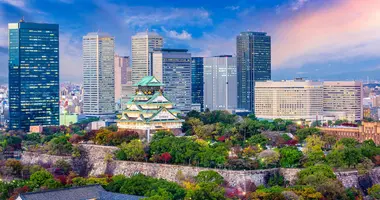
City break - Osaka tour Self-Guided Tours in Japan
- Duration : 8 days
- Locations : Osaka
- Included : Airport Transfers, 3* Hotels, Non-flight transportation, Guided activity, Travel diary, Pocket wifi, Assistance
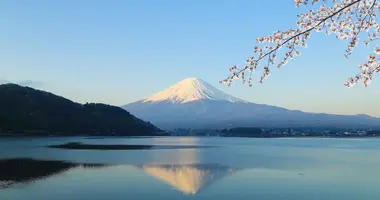
Tokyo, Mount Fuji & Kyoto Self-Guided Tours in Japan
- Duration : 10 days
- Locations : Tokyo, Hakone Mt Fuji, Kyoto
- Included : Airport Transfers, 3* Hotels & Ryokan, Non-flight transportation, Guided activity, Travel diary, Pocket wifi, Assistance
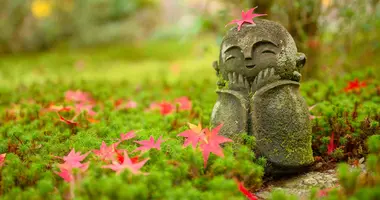
Japanese Immersion Self-Guided Tours in Japan
- Duration : 13 days
- Locations : Tokyo, Hakone Mt Fuji, Hiroshima, Osaka, Koyasan, Kyoto
- Included : Airport Transfers, 3* Hotels & Ryokan, Non-flight transportation, Guided activities, Travel diary, Pocket wifi, Assistance
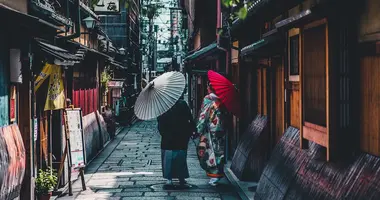
Romantic tour in Japan Self-Guided Tours in Japan
- Locations : Tokyo, Hakone Mt Fuji, Okayama, Miyajima, Kyoto
- Included : Airport Transfers, 3* Hotels & Ryokan, Japan Experience house, Non-flight transportation, Guided activities, Travel diary, Pocket wifi, Assistance
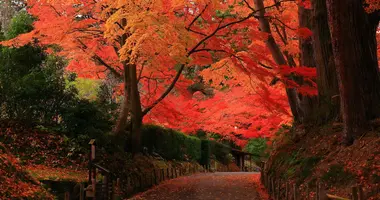
Tohoku: Traditional Japan Self-Guided Tours in Japan
- Duration : 18 days
- Locations : Kyoto, Tokyo, Nikko, Sendai, Tohoku, Aomori
- Included : Airport Transfers, 3* Hotels & Ryokan, Japan Experience house, Non-flight transportation, Guided activity, Travel diary, Pocket wifi, Assistance
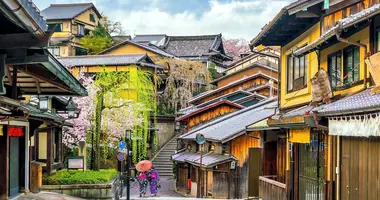
Slow Travel Japan Self-Guided Tours in Japan
- Duration : 21 days
- Locations : Tokyo, Hakone, Kyoto, Osaka, Hiroshima, Okayama
- Included : 3* Hotels & Ryokan, Airport Transfers, Non-flight transportation, Travel diary, Pocket wifi, Assistance, Activities
Our activities in Tokyo, Kyoto, Nara
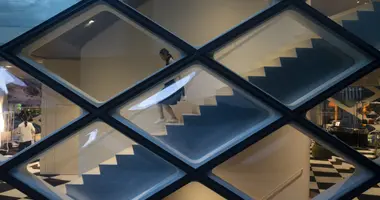
Tokyo Architectour Activities in Tokyo
- Duration : 8 hour
- Location : Minato City

Butoh Dance Activities in Kyoto
- Duration : 45 minute
- Location : Kyoto
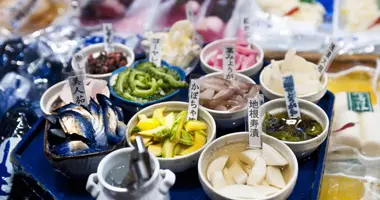
Culinary tour in Kyoto Activities in Kyoto

Wagashi, Japanese pastry Activities in Kyoto
- Duration : 1 hour
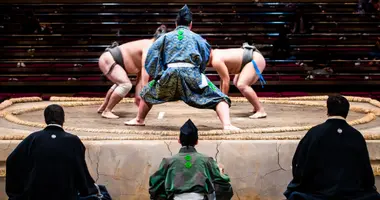
Tokyo Sumo Tournament (January, May and September) Activities in Tokyo
- Duration : 3 hour
- Location : Tokyo

Kabuki, the Japanese popular theatre Activities in Tokyo
Please select your country on the list below:
- Switzerland
- United Kingdom
- Other countries
- Plan a Road Trip
- Plan a Flight
- Find an Airport
- Where to Stay
- All Questions
Kyoto to Tokyo drive
Kyoto to tokyo road trip planner.
Here's a sample itinerary for a drive from Kyoto to Tokyo. If you're planning a road trip to Tokyo, you can research locations to stop along the way. Make sure you check road conditions to double check the weather. Find the best hotels, restaurants, and attractions based on the most talked about places recommended by Trippy members.
11:00 am start in Kyoto drive for about 2 hours
12:56 pm Nagoya stay for about 1 hour and leave at 1:56 pm drive for about 54 minutes
2:50 pm Kenchōji Sugiyama stay for about 1 hour and leave at 3:50 pm drive for about 1 hour
day 1 driving ≈ 4 hours find more stops
11:00 am leave from Shimada drive for about 1 hour
12:06 pm Mt. Fuji stay for about 1 hour and leave at 1:06 pm drive for about 1 hour
2:10 pm Kamakura stay for about 1 hour and leave at 3:10 pm drive for about 54 minutes
4:04 pm arrive in Tokyo stay at The Peninsula Tokyo
day 2 driving ≈ 3 hours find more stops
Kyoto to Tokyo questions
Where should I stop along the way?
Nagoya (9 answers) questions about Nagoya: Where to find real local food in and around Nagoya? Internet (sim or portable wi-fi) Kenchōji Sugiyama Shimada Mt. Fuji (25 mentions) Kamakura (12 answers)
Where's the best place to stay in Tokyo?
Are you going straight to a hotel, or looking for a vacation rental or Airbnb?
The best resource on neighborhoods, areas, and hotels is the Trippy page on where to stay in Tokyo .
If you're looking for a quick answer, you can check out The Peninsula Tokyo , which was mentioned 5 times on Trippy.
Here are some more hotels people talk about:
Want to research more popular hotels in Tokyo? Click the blue button below.
Where's the best place to eat in Tokyo?
Need some recommendations on somewhere to get food?
Trippy members suggest Golden Gai , which was mentioned 6 times.
Here are some more restaurants people talk about:
Want to research more popular restaurants in Tokyo? Click the blue button below.
What are some things to do in Tokyo?
This section could be endless, so rather than trying to suggest every local activity or attraction, we'll leave it open-ended.
These are some of the places people talk about on Trippy:
Of course, Trippy is the perfect place to ask questions because there's an entire community of travelers talking to each other and sharing tips and advice. Trippy is where you can get answers personalized for your tastes, budgets, trip dates & more!
For example, here are some questions people have asked about Tokyo. Click on any question to see answers from the community!
Click the button below to explore more questions and answers related to Tokyo.
Do I really have to go back home?
Yes, even this step is optional, because if you're on vacation who wants the trip to end? It's okay, you can start planning your next trip!
Want to plan the trip back? Get the reverse directions for a Tokyo to Kyoto drive , or go to the main page to plan a new road trip .
You can also compare the travel time if you're flying or driving by calculating the distance from Kyoto to Tokyo . Or get a full Kyoto to Tokyo flight plan .
Don't forget about exploring your own hometown with a staycation. You can also find some cool day trips or get away for a weekend.
And if you know Kyoto well, please help your fellow travelers and answer their questions about Kyoto!
More info on this route:
road conditions from Kyoto to Tokyo
places to eat
alternate routes
Google driving directions
Nomadic Matt's Travel Site
Travel Better, Cheaper, Longer
The Perfect 7-Day Japan Itinerary for First-Time Visitors

Japan captured my heart from the moment I firs visited. The delicious food, the rich culture, breathtaking landscapes, vibrant history, and the very friendly and polite people – it all blew my mind.
But Japan often feels impenetrable, especially to first-time visitors. While I think Japan deserves a minimum of 10 days, I get that some people might only have a week, so I wanted to write this, my ideal seven-day itinerary for Japan for a first-time visitor.
With only a week, there’s not much you can see unless you really rush it. And I don’t think you should do that.
So this itinerary only focuses on Tokyo and Kyoto (the most popular destinations) as well as some day trips from each. If you wanted to rush things a little, you could add in Osaka (more on that at the end).
(Note: If you purchased a Japan Rail Pass , activate it on arrival. That way, you can take advantage of the free JR trains throughout the city.)
Table of Contents
Japan Itinerary Day 1: Tokyo
Japan itinerary day 2: tokyo, japan itinerary day 3: tokyo, japan itinerary day 4: kyoto, japan itinerary day 5: kyoto, japan itinerary day 6: nara, japan itinerary day 7: tokyo, an alternative itinerary.

Tsukiji and Toyosu Fish Markets Cure your jet lag with some food! In 2018, Tokyo’s main fish market moved to Toyosu. It is now twice the size of Tsukiji (the old one), making it the largest such market in the world. Here you can eat fresh sushi for breakfast, just a few feet from where it was hauled in from the sea, while marveling at the chaotic atmosphere.
You can still head to the old market in Tsukiji to eat, shop, and wander as well. I like it a lot, because there are more food options! Food and drink tours of the Tsukiji Outer Market are available for around 15,000 JPY.
Toyosu Fish Market is open Monday-Saturday 5am-5pm, though most shops don’t open until 7am. Admission is free, but you have to pick up a visitor’s pass when you enter. Tsukiji Fish Market’s hours vary by shop (usually 5am-2pm). Admission is free.
teamLab Planets This digital art installation is a multi-sensory and immersive experience in which you become part of the artwork, walking barefoot through the four exhibition spaces and gardens as you interact with the installations’ elements in unique ways. It’s really fun! TeamLab is generally sells out in advance, so I recommend getting your tickets online ahead of time .
Take a walking tour Walking tours are a great way to get the lay of the land while connecting with a local guide. I always go on one or two when I arrive somewhere. Tokyo Localized offers many free tours, including a classic overview and ones of both the famed Harajuku and Shinjuku neighborhoods. Its Imperial Palace tour would be the most convenient one after teamLab.
The Imperial Palace Formerly Edo Castle, the Imperial Palace was built in the 15th century, and some of the walls and moats from that time are still in use to this day. When the emperor moved from Kyoto to Tokyo in 1869, he took Edo for his new palace and renamed it. While you can’t go inside, it is surrounded by beautiful grounds, a moat, and a park worth wandering through. You can also see the changing-of-the-guard ceremony (though it’s relatively low-key and unassuming). Admission to the grounds is free.
Shinjuku Gyoen National Garden This park is over 144 acres and home to some 20,000 trees. Most of the original park was destroyed in World War II but was rebuilt and reopened in 1949. During spring, it is one of the best places to see cherry blossoms. My favorite area is the landscape garden, which has several ponds with bridges and islands. It’s a peaceful oasis away from the urban hustle and bustle.
Depending on how you feel relative to your jetlag, you could fit a few more activities before you end your day. Check out this post for suggestions .

- Senso-ji – This is Tokyo’s most popular and famous temple. Beautifully painted, it sits in a scenic spot near a pagoda and the lovely Kaminari Gate. There’s a huge statue of Kannon, the goddess of mercy, inside the main hall. It’s very busy during the day, so maybe check out the grounds in the evening.
- Asakusa Shrine – This nearby Shinto shrine is much more peaceful, with fewer visitors, but with people praying, meditating, or performing traditional rituals. It was built during the Edo period (1603–1868) and survived the air raids of World War II.
Afterward, head to Ueno Park . Spanning over 133 acres, Ueno Park was established in 1873 on land formerly owned by a 17th-century Buddhist temple. It gets super busy in cherry blossom season, as there are over a thousand trees here. Throughout, you’ll find various stalls and vendors selling snacks, drinks, and souvenirs. On weekends, there are usually cultural events or festivals showcasing traditional arts, music, and dance. Four of Tokyo’s main museums are here:
- Tokyo National Museum – Established in 1872 on the north end, this massive building is the oldest and largest art museum in Japan. It houses one of the world’s largest collections of art and artifacts from Asia, particularly Japan.
- Tokyo Metropolitan Art Museum – This museum showcases rotating exhibitions of contemporary and traditional Japanese art.
- National Museum of Nature and Science – This museum features a wide range of permanent and temporary exhibitions covering natural science and history.
- Tosho-gu Shrine – This beautiful 17th-century Shinto shrine has carved gold doors and other ornate carvings. It’s worth seeing up close!
Afterward, walk down to Akihabara to explore the video game parlors, arcades, and anime shops. This very buzzy area is ground zero for all things electronic, and it’s fun to play many of the games. This is where you’ll find the famous maid cafés, where servers dress up as maids and serve you food and drinks. These range from big touristy ones to holes-in-the-wall (the girls on the street are promoting the latter, which are a lot more culturally fun). They aren’t cheap, though, as you have to buy drink packages and pay a fee, but they’re kitschy and fun.
In the evening, visit Shinjuku and then drink in Golden Gai . In Shinjuku, you’ll find a plethora of cool bars, bright lights, and tiny hole-in-the-wall eateries. Be sure to wander down Memory Lane (aka Piss Alley) for tiny izakaya joints and bars. Afterward, head over to Golden Gai, a warren of narrow alleyways with a bit of a red-light-district feel, flanked by diminutive backstreet bars. It’s quite touristy but also a lot of fun. I’ve had some wild nights here!
With Arigato Tours , you’ll learn about the neighborhood while stopping to sample Japanese classics like sushi, yakitori, and ramen. The 23,900 JPY cost includes a drink and dishes at four stops.

Kamakura Here you can see a 13-meter (43-foot) bronze statue of Buddha that was built in 1252. It was initially constructed within Kotoku-in Temple, but that has since been washed away by several storms, so it now sits in the open air. Admission to enter the temple grounds is 300 JPY, while it’s 20 JPY to go inside the statue. The journey there — around an hour — is free with a Japan Rail Pass .
Tokyo Disneyland I’m a sucker for Disney. You’ll find many of the same classic rides from Disney World here, like Splash Mountain, Big Thunder Mountain, The Haunted Mansion, and everyone’s favorite teacup ride, The Mad Tea Party. But there are several unique attractions as well, like Pooh’s Hunny Hunt and Journey to the Center of the Earth.
Ticket prices vary depending on the day and time, but full-day admission begins at 7,900 JPY for adults and 4,400-6,200 JPY for children. It’s best to book in advance .
Mount Fuji Mount Fuji is located an hour outside of Tokyo. An active stratovolcano (which last erupted in 1708) and covered in snow for almost half of the year, it stands an impressive 3,776 meters (12,389 feet) and provides one of the most iconic views in the country. One of the Three Holy Mountains of Japan, Mount Fuji is both a Special Place of Scenic Beauty and a UNESCO Cultural Site. In the summer, the mountain is open to hikers, who take 5-12 hours to reach the summit (traditionally, they depart at night to arrive at the top for the sunrise).
If you don’t want to hike, you can simply visit on a day trip. There are buses that can take you partway up, where you’ll be offered sweeping vistas of the surrounding area. Guided day tours from the city cost around 12,000 JPY.

Wander the Bamboo Forest For a relaxing break, head to Arashiyama and let the dense and towering stands of bamboo envelop you. Located near the famous Tenryu-ji temple, it’s one of the most beautiful places in the entire country. It’s not that big, but there are some hidden areas to explore. Just make sure to arrive early if you want to enjoy it without the crowds (it fills up fast after sunrise).
While there, I would also recommend visiting the Okochi Sanso Garden, which (along with the home) belonged to the famous Japanese actor Denjir? ?k?chi (1898–1962). It’s not free (it’s 1,000 JPY), but it’s really nice and has some wonderful views.
Visit the Golden Pavilion Originally built in the late 14th century as a retirement villa for the shogun (military governor), this iconic structure was later converted into a Zen Buddhist temple. The present-day edifice dates only to the 1950s, however, when a monk attempting to kill himself burned the historic original to the ground. The rebuilt temple is covered in brilliant gold leaf, symbolizing purity and enlightenment. Each of the three stories exhibits a different architectural style. Completing the scene are the serene reflecting pool and traditional Japanese gardens that contain lush foliage, manicured trees, and scenic walking paths.
1 Kinkakuji-cho, Kita-ku, Kyoto-shi, Kyoto, +81 075-461-0013, shokoku-ji.jp. Open daily 9am-5pm. Admission is 500 JPY.
Admire Ryoan-ji Temple This is my favorite temple in Kyoto. Originally established in 1450 as a residence for a high-ranking samurai, it was soon converted into a Zen temple and is now a UNESCO World Heritage Site, with a mausoleum that houses the remains of seven emperors. Its traditional rock and sand garden is considered one of the best in the country. There’s also a teahouse where you can experience the traditional Japanese tea ceremony ( chanoyu ) as you overlook the Kyoyochi reflecting pool.
There are other temples in the area to check out as well:
- Daitoku-ji Temple – This massive complex dating back to 1315 covers almost 60 acres. It contains several dozen temples and is a good place to see a variety of Zen gardens and architectural styles. It’s also deeply linked to the Japanese tea ceremony, as several of the country’s most noteworthy masters studied here.
- Toji Temple – This is home to Japan’s tallest pagoda (five stories high). Founded in 796, just after Kyoto became the capital, it was one of only three Buddhist temples allowed in the city.
Go on a sake brewery tour Kyoto has a sake (rice wine) brewing tradition going back 400 years and is known for some of the best in the world, due to using the area’s pure natural spring water in the brewing process. Arigato Tours offers an excellent three-hour tour of Fushimi (the brewing district) for 23,320 JPY, including stops at several breweries, a guided tour of the Gekkeikan Okura Sake Museum, and tastings.

See the Fushimi Inari Shrine This mountainside Shinto shrine, dating back to 711, is dedicated to Inari, the god of rice and prosperity. It’s known for its thousands of vibrant orange torii gates that form a network of trails leading up Mount Inari. You can hike the trails on your own while enjoying panoramic views of Kyoto below or join a guided hiking tour , on which you’ll get off the paved paths and into hidden bamboo groves. Get here as early as possible to avoid the crowds.
68 Fukakusa Yabunouchicho, +81756417331, inari.jp. Open 24/7. Admission is free.
Walk around Higashiyama Spend an afternoon walking along the narrow streets of one of the oldest and best preserved districts on your own or on a walking tour . The traditional machiya buildings (traditional wooden townhouses) are filled with small shops selling local specialties and handicrafts, as well as restaurants and teahouses. It’s a popular area in which to participate in a tea ceremony . Another nice place to stroll in this neighborhood is the Philosopher’s Path, which follows a cherry-tree-lined canal that’s beautiful and meditative even when the blossoms aren’t in season.
Visit Kiyomizu-dera One of a number of UNESCO sites in ancient Kyoto, Kiyomizu-dera (meaning “pure water temple”) is located in the foothills of Mount Otowa in the eastern part of the city. It’s one of the most famous temples in all of Japan. It was established in 778, but most of the existing buildings date to the 17th century. There’s not a single nail used in the construction, which becomes all the more impressive once you see how large the temple is, which is best known for its wooden terrace that juts out over the hillside. The temple’s name comes from the nearby waterfall whose waters (from which you can still drink today) are said to have wish-granting and healing powers.
1 Chome-294 Kiyomizu, +81 75-551-1234, kiyomizudera.or.jp. Open daily 6am-6pm. Admission is 400 JPY.
Explore Shorin-ji Temple This small temple dates back to the 16th century. What makes it worth visiting is its meditation classes. You’ll get to tour the temple and then be instructed in zazen , the Japanese style of meditation. It’s a very unique experience and something that I think will add a lot of depth and nuance to your visit (especially if you’ve seen a lot of temples). Just make sure to dress comfortably.
15 Chome-795 Honmachi, +81 75-561-4311, shourin-ji.org. Open daily 10am-4pm. Admission is 800 JPY.
Wander the Nishiki Market Nishiki Ichiba is now one of the biggest indoor markets in town. Known as “Kyoto’s Kitchen” and spanning over five blocks, it is full of vendors selling traditional dishes from the region, classic Kyoto souvenirs, and really just about anything else. There are over a hundred stalls here, many of which have been in the same family for generations. Opening hours depend on the shop but are typically from 9am to 6pm.
To dive deeper into Japanese food culture, you can take a food tour of the market . It’s the best way to learn about all the food you’ll see, as well as the market’s history.
Explore Gion Gion, the historic geisha district, is renowned as being one of the most iconic and atmospheric areas of town. It’s known for its traditional wooden machiya houses, narrow alleyways, cobblestone streets, and preservation of geisha (known locally as geiko) culture. Lining the main street are ochayas (teahouses where geishas entertain), small shops, and many restaurants, ranging from upscale kaiseki restaurants serving traditional Kyoto cuisine to casual eateries.
To really learn more about this amazing party of town and its past, take a walking tour of Gion . You’ll learn a ton and get a lot of context. They cost around 1,800 JPY.
At night, go to the Pontocho Row , a narrow street lined with restaurants, hole-in-the-wall bars, and jazz clubs. It’s one of the more lively areas in Kyoto.

Nara was the capital of Japan in the eighth century, so there are lots of buildings and temples here that are upwards of a thousand years old (which is rare in Japan, due to the prevalence of fires and earthquakes, as well as World War II). Some things to do:
- Frolic with deer – The real draw in Nara are the deer. Since the 17th century, those in and around the city have been considered sacred. You can buy crackers to feed them or just watch them stroll around carefree.
- See the Buddha – Don’t miss a visit to Todai-ji, the world’s largest wooden building, home to a 16-meter (52-foot) Buddha statue. It was built in 738 and is now a UNESCO World Heritage Site.
- Take a walking tour – This guided half-day walking tour for 11,500 JPY includes all of Nara’s highlights as well as a traditional lunch.

Ryogoku Kokugikan, Japan’s most famous sumo wrestling arena, hosts tournaments three times each year, in January, May, and September. Tickets sell out quickly, so book online in advance. Prices vary but start around 3,200 JPY for arena seats. You can book a ticket online here (you’ll be accompanied by a guide too, so you can learn more about the tradition as it unfolds before your eyes).
To learn more about the sport in in the off-season, book a tour of a sumo stable .

So, if you want to add another city to this itinerary you can follow this breakdown:
- Days 1 & 2: Tokyo
- Days 3 & 4: Kyoto
- Day 5: Nara
- Days 6 & 7: Osaka
Tokyo, Kyoto, and Nara are all covered above. As for Osaka, some of my favorite things to see and do:
Take a food tour Known as “the Kitchen of Japan,” Osaka boasts a diverse culinary scene. Mouthwatering sushi and sashimi, Kobe beef and Japanese BBQ, and flavorful ramen can all be found here in abundance. Plus, there are local specialties like okonomiyaki (a savory pancake with egg and vegetables) and kushikatsu (kebab skewers). You can take a food tour for around 13,000 JPY, a ramen and gyoza cooking class for 9,500 JPY, or just wander and eat.
Osaka Castle One of the most famous landmarks in the country, the castle was originally built in the late 16th century by Toyotomi Hideyoshi and played a pivotal role in the unification of Japan during the Sengoku period (1467-1615). Over the centuries, it has been destroyed and rebuilt multiple times due to wars, fires, and natural disasters. The current version dates to 1931. The castle is situated amid sprawling grounds and surrounded by a moat. It’s also home to a small but insightful museum and an observation deck that offers some picturesque urban views.
Dotonbori This is arguably Osaka’s most iconic district, known for its vibrant nightlife (bars, clubs, theaters, and music venues), colorful signage, and delicious food. It’s best seen at night due to the plethora of huge neon lights and signs lining both the canal and streets, which have become symbols of Osaka’s nightlife. A guided walking tour that includes Dotonbori as well adjacent neighborhoods is 6,500 JPY.
Shitennoji Temple This temple is one of the oldest Buddhist temples in Japan, founded in 593. The architecture is a blend of traditional Japanese and East Asian styles, featuring impressive pagodas, gates, and shrines set amid serene gardens. Stroll through the tranquil grounds, admire the beautiful architecture, and learn about the temple’s historical and cultural significance at the museum. The temple is 300 JPY to enter, the garden is 300 JPY, and the museum is 500 JPY.
Japan is one of my favorite countries. While it’s relatively small, it offers an amazing array of things to see and do (as well as some of the best food in the world). With seven days, you can easily see a good number of the main highlights and get a taste for the incredible history and culture. It will be a busy week, but this itinerary ensures you’ll still have some time to slow down, relax, and take in the local pace of life.
Just make sure you get a Japan Rail Pass before you go. While it’s not as cheap as it used to be, it will likely save you time and money!
Book Your Trip to Japan: Logistical Tips and Tricks
Book Your Flight Find a cheap flight by using Skyscanner . They are my two favorite search engines, because they search websites and airlines around the globe, so you always know no stone is being left unturned!
Book Your Accommodation You can book your hostel with Hostelworld as they have the most comprehensive inventory so they are best for booking a hostel. If you want to stay in a hotel or guesthouse in Japan, use Booking.com as it consistently returns the cheapest rates for guesthouses and hotels.
Don’t Forget Travel Insurance Travel insurance will protect you against illness, injury, theft, and cancelations. It’s comprehensive protection in case anything goes wrong. I never go on a trip without it, as I’ve had to use it many times in the past. My favorite companies that offer the best service and value are:
- Safety Wing (best for everyone)
- Insure My Trip (for those over 70)
- Medjet (for additional evacuation coverage)
Looking for the Best Companies to Save Money With? Check out my resource page for the best companies to use when you travel! I list all the ones I use to save money when I travel — and I think they will help you too!
Be sure to check out the Japan Rail Pass if you’ll be traveling around the country. It comes in 7-, 14-, and 21-day passes and can save you a ton of money!
Looking for More Travel Tips for Japan? Check out my in-depth Japan travel guide for more ways to save money, information on costs, tips on what to see and do, suggested itineraries and reading and packing lists, and much, much more!
Got a comment on this article? Join the conversation on Facebook , Instagram , or Twitter and share your thoughts!
Disclosure: Please note that some of the links above may be affiliate links, and at no additional cost to you, I earn a commission if you make a purchase. I recommend only products and companies I use and the income goes to keeping the site community supported and ad free.
Related Posts

Get my best stuff sent straight to you!
Pin it on pinterest.
- Tokyo Tourism
- Tokyo Accommodation
- Tokyo Bed and Breakfast
- Tokyo Holiday Rentals
- Tokyo Flights
- Tokyo Restaurants
- Tokyo Attractions
- Tokyo Travel Forum
- Tokyo Photos
- All Tokyo Hotels
- Tokyo Hotel Deals
- Things to Do
- Restaurants
- Holiday Rentals
- Travel Stories
- Rental Cars
- Add a Place
- Travel Forum
- Travellers' Choice
- Help Centre
Travel to Kyoto first then return back to Tokyo from S F? - Tokyo Forum
- Asia
- Japan
- Kanto
- Tokyo Prefecture
- Tokyo
Travel to Kyoto first then return back to Tokyo from S F?
- Australia Forums
- United States Forums
- Europe Forums
- Canada Forums
- Asia Forums
- Central America Forums
- Africa Forums
- Caribbean Forums
- Mexico Forums
- South Pacific Forums
- South America Forums
- Middle East Forums
- Honeymoons and Romance
- Business Travel
- Train Travel
- Traveling With Disabilities
- Tripadvisor Support
- Solo Travel
- Bargain Travel
- Timeshares / Holiday Rentals
- Tokyo Prefecture forums
- Tokyo forum

2 replies to this topic

However, it might be cheaper to get a round trip ticket to Tokyo. In that case, consider taking the train to Kyoto on the same day you arrive in Tokyo only if your flight arrives early in the day and you expect to be awake and alert after a very very long flight . You do not want to fall asleep on the Shinkansen and miss your stop in Kyoto, or arrive in Kyoto too tired to remember the name of your hotel! Most people getting a round trip flight ticket to Tokyo would choose to spend several days in Tokyo, then take the train to Kyoto, take the train back to Tokyo, and spend a few days in Tokyo before departure. This scenario gives you the opportunity to stay in 2 different neighborhoods in Tokyo. If you're nervous about getting to the airport on time, you could make the second stay in Tokyo just one day but stay at an airport hotel. If you have one day at Narita, the Naritasan Temple is a great day excursion.

HND is much closer to Tokyo/Yokohama that you may stay o/n in either prior to departure. Depending on hotel location HND can be within 1 hour of taking either frequent limo bus or commuter trains direct.
- What to do with left out currency? 17:14
- Train peak hour? 17:14
- Express bus to Oshino Hakkai 17:09
- Boarding pass to re-enter security at Haneda 17:08
- Tea ceremony and flower arranging 16:39
- Overnight near Narita airport 15:12
- Can we see Mt.Fuji while going from Kyoto to Tokyo? 14:39
- Travel to Kyoto first then return back to Tokyo from S F? 14:33
- 3 days sightseeing in Tokyo 14:10
- What would you do/where would you stay for 24 hours in Tokyo 12:51
- Transiting through Haneda Terminal 2 to Terminal 3 11:13
- QR Codes for Narita immigration and taxi or Uber from Narita 11:05
- Narita Airport question- where to meet friends 10:01
- Spending Money 13 days (Australia family) 09:42
- Best area to stay in Tokyo for young adults? 25 replies
- top 10 best places to go in tokyo in 4 days? 10 replies
- Power adaptors from Australia to Japan 5 replies
- How many days in Tokyo 17 replies
- Confused with which area to stay 20 replies
- New Years Eve Tokyo 2012 32 replies
- Where to stay in my first time in Tokyo. 17 replies
- Strange, Odd, Weird Things to see and do in Tokyo/Japan 12 replies
- 1st time in tokyo... where to stay?Ginza Shinjuku or Shibuya 23 replies
- Weird things to do in Tokyo? 22 replies
Tokyo Hotels and Places to Stay
- Sample 5 Day Itinerary
- Christmas & New Years in Tokyo?


16 Japanese Cities To Visit Besides Tokyo And Kyoto
- Osaka: Experience incredible nightlife and outstanding cuisine in this seaside city known for its energetic atmosphere and delicious food.
- Naoshima: Discover the art island with its galleries, sculptures, and installations, and enjoy the tranquil atmosphere and sea views.
- Himeji: Visit the UNESCO World Heritage Site Himeji-jo castle and explore the picturesque Mount Shosha and Kokoen garden for a diverse cultural experience.
As Japan finally opens its borders to eager travelers after one of the strictest lockdowns that the world has seen, most itineraries focus on the shopping districts of Tokyo and the Buddhist temples of Kyoto. Occasionally, the street food of Osaka might make it to the list.
Few consider venturing beyond the big cities of Tokyo and Kyoto, but for those who dare try, thrilling adventures await in Japan's best cities. From former homes of samurai warriors and current cities of geishas, hot springs spas, traditional architecture, and ski mountains — these cities deserve a spot on everyone’s Japanese bucket list.
UPDATE: 2023/10/09 19:32 EST BY MARIA BOU INK
Japan's beauty is not limited to Tokyo and Kyoto. The country is a hub of wonderful towns that are worth a trip. Therefore, this list was updated to include two of the best cities to visit in Japan besides Tokyo and Kyoto.
Related: Beautiful Tourist Pics Showcasing The Best Things Japan Is Known For
If tourists want to sample some of the greatest cuisine and beverages Japan has to offer, they should head over to Osaka , a seaside city famed for its incredible nightlife and outstanding cuisine. Tokyo's big-city energy is also present here but on a little lesser scale. This way, tourists can visit cities in Japan other than Tokyo and Kyoto while having the same vibes and escaping the crowds. Tourists are recommended to visit the Osaka Castle and Park in between all of their eating and exploring. It is one of the most well-known sights in Japan and is definitely worth visiting.
- Some attractions: Tempozan Ferris Wheel, Universal Studio Japan, Osaka Aquarium Kaiyukan, etc.
The island of Naoshima, which is reachable via ferry, is a wonderful location. The area is referred to as the art island, and tourists may find galleries, sculptures, and installations everywhere they go, especially if they stay at the upscale Benesse House, which serves as both a hotel and a museum of modern art. On the island, there are two towns, both of which include charming stores and little restaurants. There are also sea views everywhere, which enhances the tranquil atmosphere.
- Some attractions: The Yellow Pumpkin, Chichu Art Museum, Naoshima Public Bath I Love Yu, etc.
Home to a UNESCO World Heritage Site castle , Himeji is worth a special trip for the Himeji-jo castle alone. Widely considered to be the finest example of 17th-century feudal-era Japanese architecture that still survives, Himeji-jo may be the reason tourists visit this city in Japan, but Himeji gives them several reasons to stay. On the outskirts of the city is the picturesque Mount Shosha, with a Buddhist temple at its peak. And if a hike isn’t someone’s cup of tea, tourists can spend a day at the Kokoen garden, which is made of nine walled gardens connected by a network of streams, waterfalls, and ponds and sits on the former feudal lord’s residence.
- Some attractions: Himeji Castle, Engyoji, Himeji Central Park, etc.
Related: Three Days In Japan: 10 Cities You Can Explore In Only 72 Hours
Matsue’s location on a peninsula by the Sea of Japan with Lake Shinji on its west and Lake Nakaumi on the east has given the city another name: The City of Water. While the water bodies that surround it have given Matsue its second name, there are also water bodies within the city. Canals with boat tours for tourists flow through the city, old samurai houses flank its streets, and Matsue is home to one of only twelve medieval castles that are preserved in their original state in Japan. But that’s not all: the city has long attracted curious travelers with its rich myths and legends related to Matsue being the place where Japanese gods descend.
- Some attractions: Matsue-jō Castle, Yuushien, Yaegaki Shrine, etc.
Yokohama is the second-largest Japanese city and the first to have opened its ports to the world at the end of the Edo Period. The port city quickly transformed from a small fishing village to a major city when foreign trade introduced new cultures to the old Japanese traditions of the village. As a result, Yokohama offers a contrast between old and new, and travelers can explore the streets of Yokohama to see the Western influence on the Japanese way of life everywhere. Tourists can visit traditional Japanese gardens and tea rooms, ramen and instant cup noodle museums, giant ferry wheels reminiscent of the London Eye, and one of the largest Chinatowns in the whole country.
- Some attractions: Shin Yokohama Ramen Museum, Yokohama Chinatown, Yokohama Cosmoworld, etc.
For those who like the crowds of Tokyo but wish for a city just a tad more quite than the Japanese capital, Fukuoka’s contemporary attractions make it the ideal city. Fukuoka is Japan’s eighth most populous city and balances urban life with the natural beauty that is synonymous with Japan. The port city is filled with hot springs, hike trails, tea plantations, and sake breweries. But the best part, perhaps, is the fact that Fukuoka happens to be the city that invented tonkatsu ramen , so for those who’d like to slurp their way through Japan via its ramen, Fukuoka has to be the starting place.
- Some attractions: Ohori Park, Marine World, Uminonakamichi Seaside Park, etc.
Hokkaido is an island region of Japan that is known for its hot springs, ski mountains, and volcanoes. Hakodate — located on the island’s southern tip — is one of the largest cities in Hokkaido and was voted Japan’s most attractive city in 2015. Visitors can hike to Mount Hakodate and enjoy spectacular views of the city surrounded by the sea, soak in the hot springs, go down ski slopes, or take in the views of the Mount Komagatake volcano from the lakes of Onuma Park. The best part of the port city, however, is its food. Surrounded by the sea, Hakodate is famous for its freshly-caught seafood, and the Hakodate Morning Market is the best place to enjoy it.
- Some attractions: Goryokaku, Goryokaku Tower, Old Public Hall of Hakodate Ward, etc.
Related: After Cherry Blossom Season, Here Are 10 Unique Activities To Enjoy In Japan This Fall
Kyoto isn’t the only city in Japan famous for its Buddhist monasteries and temples. Formerly known as Heijo-Kyo , Nara was once Japan’s capital city and is now home to three UNESCO World Heritage Sites . The Horyuji Area of Nara was the first to be on the list and includes 48 Buddhist sites, all of which are of immense importance to the Japanese culture and religion. Also on the list are areas with several temples and historical monuments from ancient times when Nara was still the capital, as well as pilgrimage routes and sites on the Kii Mountain. Tourists can end their tour of the temples and spiritual sites of Nara with a friendly visit to greet the deers at the Nara Park or stroll through Imaicho — a merchant town preserved from the Edo period that will take everyone back in time.
- Some attractions: Today-ji, Nara Park, Kasuga Taisha Shrine, etc.
Nagasaki is most often associated with the atomic bomb and the tragedy that followed. Still, the city has a lot more to offer beyond the Atomic Bomb Museum and the Nagasaki Peace Park, which attract most tourists. Not only is the city home to several stunning islands off its coast, but Nagasaki has consistently ranked on top of the list of places with the best night views in Japan . Travelers can hop onto a ropeway to the peak of Mount Inasa and enjoy spectacular views of Nagasaki as it lights up after sunset. More surprisingly, however, Japan’s first and oldest Chinatown happens to be in Nagasaki, and it has continued to serve Japanese-Chinese fusion foods since the 17th century.
- S ome attractions: Nagasaki Atomic Bomb Museum, Peace Park, Glover Garden, etc.
For those whose idea of a holiday in Japan includes spending hours soaking in hot water springs, Beppu is the place to be. Beppu’s gushes of hot spring water rank second highest in the world and the highest in Japan, gushing more than 100,000 liters of water each minute through thousands of hot springs. Not only does the abundance of hot springs make Beppu the Onsen City of Japan, but Beppu also has several boiling ponds known as Jigoku or hell. Locals use these Jigoku ponds for cooking food as well, giving rise to a culinary custom known as Jigoku-Mushi, or hell-steaming, that is peculiar to Beppu.
- Some attractions: Kannawa Hot Springs, Beppu Ropeway, Shidaka Lake, etc.
Takayama is several things: A city surrounded by the Japanese Alps, Japan’s ski destination, home to bustling morning markets and festivals dating back to the 1600s, and a place where Japanese tradition flourishes through some of the country’s most beautifully preserved villages. Takayama’s Sanmachi area, in particular, houses preserved thatched-roof houses from which antique dealers and artisans sell their wares, and hidden cafes and brewers dish out hot coffees and icy sake to any visitors who manage to spot them.
- Some attractions: Takayama Jinya, Hida Folk Village, Shinhotaka Ropeway, etc.
The city that served as the seat of the second most powerful feudal clan in Japan during the Edo period, Kanazawa has always been a place of great cultural significance in Japan. More importantly, Kanazawa was the second largest city after Kyoto, which managed to remain safe from the bombings of World War II. As a result, most of the city’s old castles, gardens, samurai, and geisha districts have survived the test of time. That being said, Kanazawa also houses the iconic 21st Century Museum of Contemporary Art and is the city where traditional teahouses and crafts, including Kaga-yuzen (a silk dying technique), ohi ware (tea ceremony bowls), and gold leaf production continue to prosper.
- Some attractions: Kenroku-en, Higashi Chaya District, Myouryouji, etc.
Related: Unwind & Relax In Japan: The Best Onsens To Soothe Your Soul
Shirakawa-go
Shirakawa-go is not a city but a traditional Japanese alpine village stuck in time . It is part of a national park and is a great place to visit to see the way things used to be in Japan. Here (and its sister village Gokayama), visitors may feel like they are living in the world of the 2003 movie, The Last Samurai starring Tom Cruise (although it was actually filmed in New Zealand).
These traditional villages are UNESCO World Heritage Listed and are a great example of how Japan works to preserve its heritage.
- Some attractions: Wada House, Gassho-zukuri Minkaen, Myozenji, etc.
Hiroshima is one of only two cities to ever be hit with a nuclear bomb . It is also a testament to how cities can bounce back from destruction, being today a thriving city of over one million people. It was founded in 1589 as a castle town but transformed into a major industrial hub (which made it a target for nuclear bombing).
Today visitors can see the UNESCO World Heritage Listed Hiroshima Peace Memorial and commemorate the bombing wishing for such destruction to never again return to this planet.
- Some attractions: Peace Memorial Park, Hiroshima Peace Memorial Museum, Atomic Bomb Dome, etc.
Sapporo is the capital of Japan's northern island of Hokkaido. It is the largest city north of Tokyo and is considered the cultural and economic center of Hokkaido. The city hosted the 1972 Winter Olympics and is one of the best places in Japan to enjoy the winter season. Come in early February and attend the Sapporo Snow Festival. The festival draws over 2 million visitors from far and wide. Additionally, Sapporo is home to the only beer museum in Japan - the Sapporo Beer Museum.
- Some attractions: Hokkaido Jingu, Moerenuma Park, Sapporo Beer Museum, etc.
Naha is the capital of the Okinawa Prefecture of Japan ( Okinawa is Japan's fifth major island ). The city has a population of around 300,000 and enjoys a humid subtropical climate (quite the opposite of Hokkaido's Sapporo). It is a stunning city and the gateway to Okinawa Island (which Americans may recall from the costly American invasion of the islands in World War Two). One of the top attractions in the city is the restored and rebuilt Shuri Castle (a former royal palace of the Ryukyu Kingdom).
- Some attractions: Shuri Castle, Naminoue Shrine, Okinawa Prefectural Museum & Art Museum, etc.
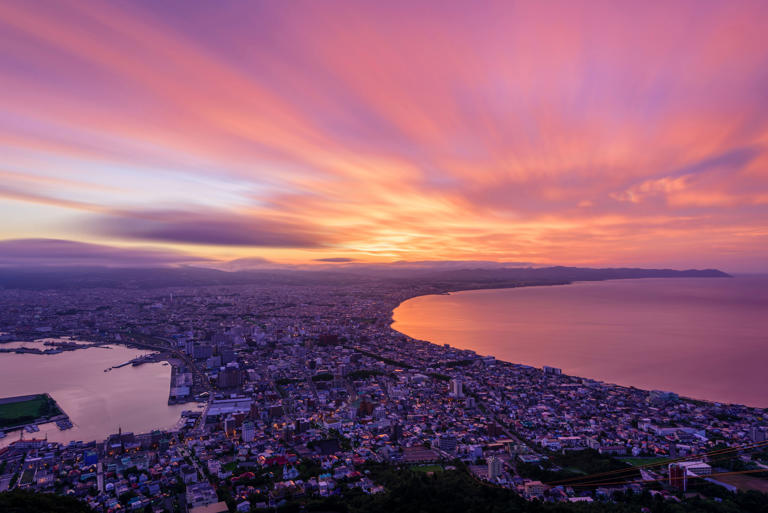

Your Career Accelerator

Tips to Succeed
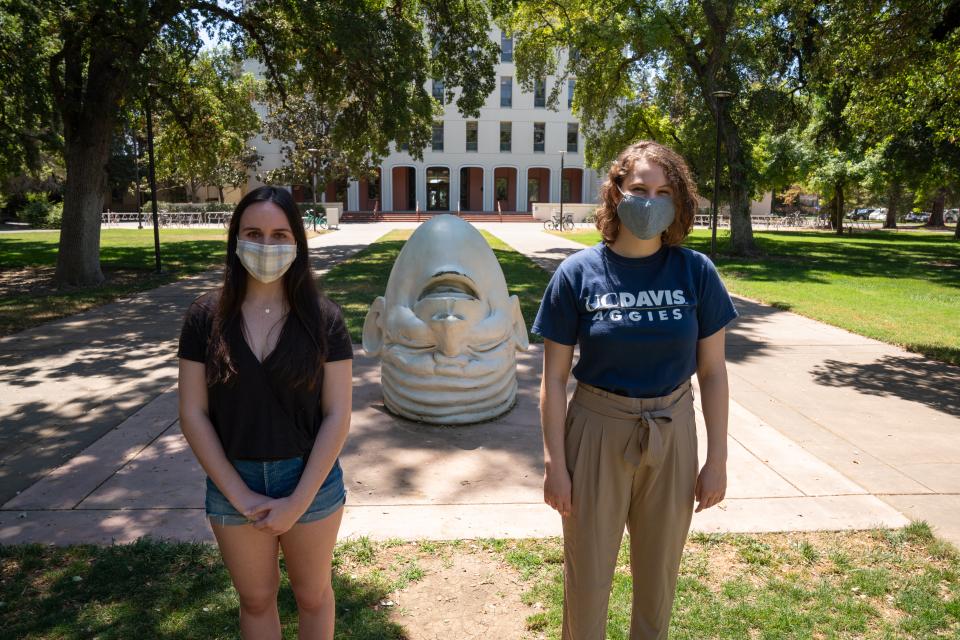
Campus COVID Information
Living with no regrets: a journey through japan.
International Study Trip explores cultures, innovation and key industries
- April 20, 2024
- Alice Vega MBA 24
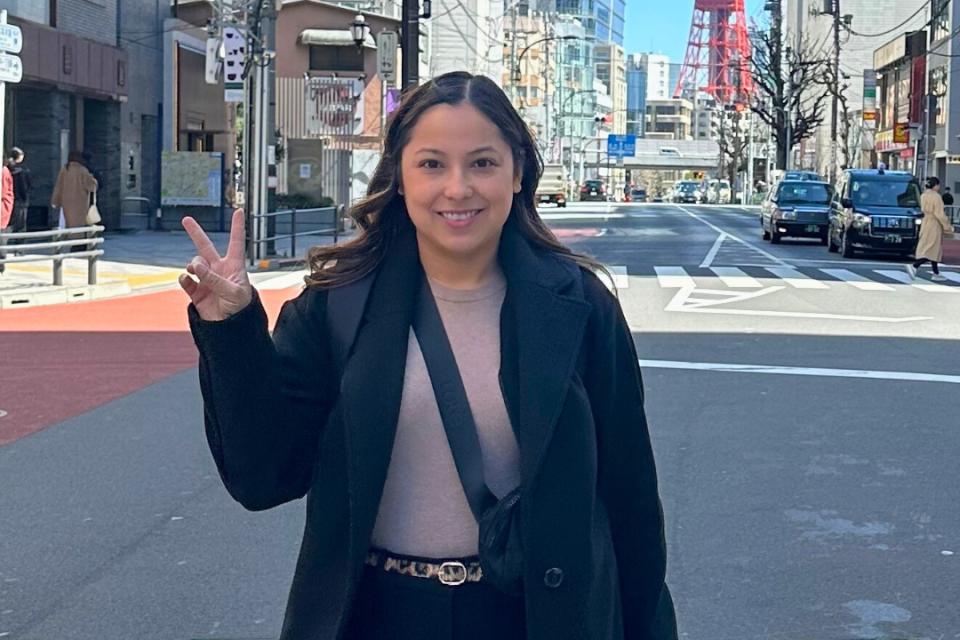
"You‘ll never regret going!"
That is what my family said as I contemplated traveling to Japan as part of my MBA experience. Studying abroad was a dream of mine. I missed the opportunity as an undergraduate at San Jose State University.
While researching business schools, I kept my eye out for study abroad courses. I found UC Davis Graduate School of Management to have a vast offering of global opportunities through their International Study Trip, International Exchange Program , and a summer session abroad at LUT University (Lappeenranta University of Technology) in Finland .
As a working professional, I found that the UC Davis MBA program’s International Study Trip to be the best choice as it only required a week away from work. The quarter-long course is led by a faculty advisor, who lectures on international business and the specifics of the targeted country. After nine weeks of studying and teamwork at UC Davis, the course culminates with a whirlwind tour of the selected country that offers firsthand exploration of how companies are impacted by global market dynamics.
Associate Professor Joseph Chen prepared us well for our trip, covering the economics of international trade, business etiquette, cultural norms, and navigating Japan.
In class, we researched and presented the businesses or organizations we would visit. We were expected to act as a resource during the tour.
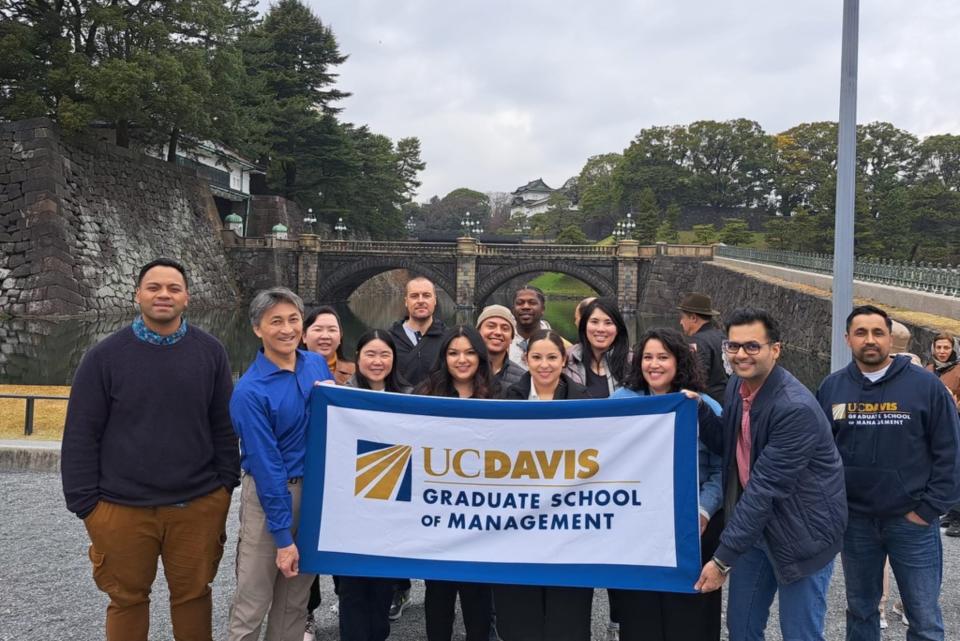
On the Ground in Japan: Exploring Tokyo, Kyoto and Osaka
By mid-March, we were ready and excited to start the journey. I arranged to travel with my friend and classmate, Marissa Hernandez MBA 25. After taking off from San Francisco, we landed in Narita on the following day and made our way to Tokyo.
Upon arriving, Marissa and I settle naturally into our roles. She was our navigator and effortlessly traversed the complicated Japanese subway system. I, on the other hand, served as an interpreter who relied on Google Maps and Google Translate for help.
During our first leg of the trip, we went to Kyoto and Osaka. In Kyoto, we saw the Nishiki Market, Arashiyama Bamboo Grove, and Fushimi Inari Shrine. I found the Fushimi Inari Shrine to be my favorite site to visit. I was amazed by the shrine's size and the surrounding mountain scenery.
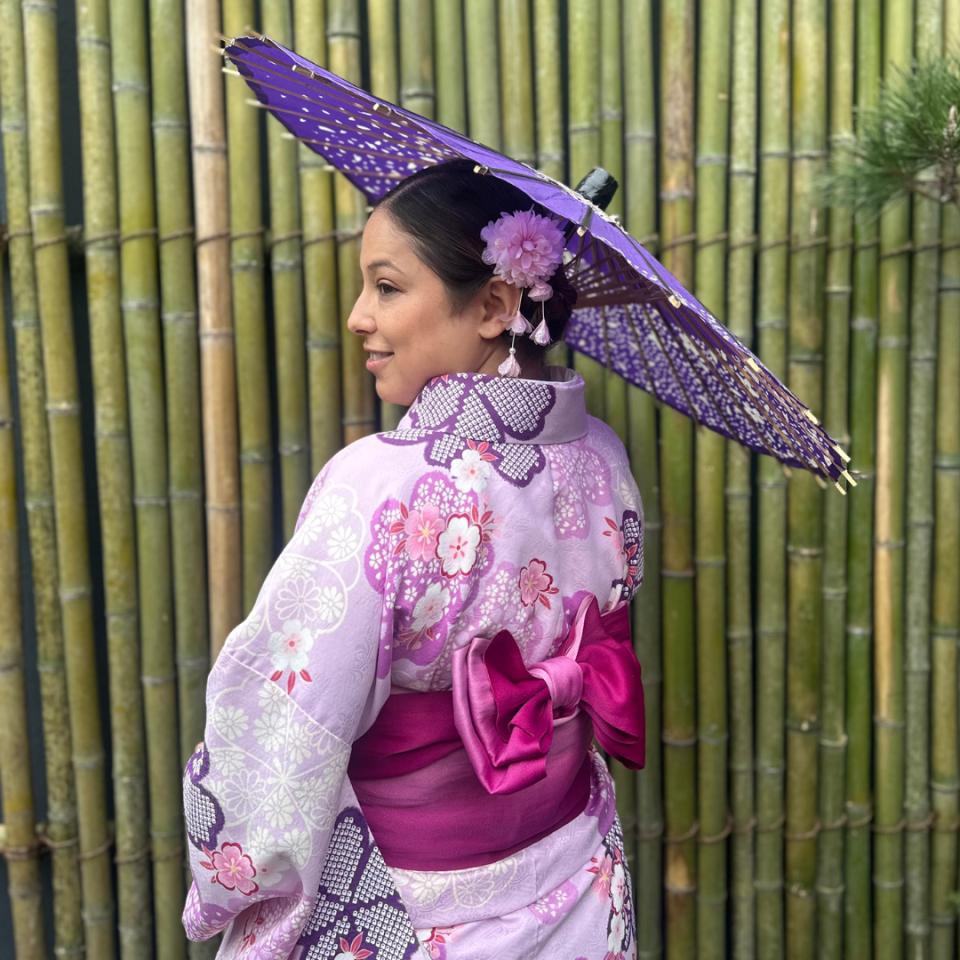
Upon our return to Tokyo, we settled into the Royal Park Hotel Shiodome in the Ginza District., Marissa and I started our morning with an immersive cultural experience at the Tokyo Maikoya Kimono Tea Ceremony. I was deeply grateful to experience a traditional Japanese tea ceremony while adorned in an intricate purple and pink kimono.
Later we met up with our classmates for a tour hosted by Jordan Metzger, the Austral Group program manager, and Tsugue (Sue) Naga, the tour guide. Sue was an amazing resource as we toured the Imperial Palace Grounds, Asakusa Temple, and the Senso-ji Shrine.
Insights from Industry
We navigated the metro to the American Chamber of Commerce thanks in part to Yuri Takahashi, program coordinator. There, we met Executive Director Laura Younger . She brought us up to speed on how the American Chamber of Commerce supports U.S. business in Japan. Younger provided us with valuable career advice about networking and also emphasized the importance of volunteering as a means to gain skills and connect with people.
The following day we took a bus to Balanced Inc. , where we met Mike Eidlin , a 2014 UC Davis graduate, who founded the cannabidiol startup in Tokyo. According to Mike, Japanese consumers are curious about CBD products. Unlike in the states, he said CBD products are very niche. Mike's motivation and passion for startups was inspirational.
Our trip continued and we met Mayu Yoneyama , account manager at Cisco Systems Japan . Yoneyama recalled with fondness studying abroad at UC Davis in 2015. We learned that Duo, the authentication tool used by UC Davis, is a part of Cisco Systems.
On our last day, we visited the Nissan Motor Corporation for their Yokohama Plant Tour. We took a well-organized tour of the showroom and engine assembly line.
After, we headed back to Tokyo to visit Bel Japon , part of the Bel Group, which makes quality cheese products. Upon our arrival, our host, HR Director Nisha Gordon, offered us Kiri cheese samples. Kiri is the local sweet and savory cheese brand popular with women. It was strange to try sweet cheeses. Everyone found the sweet cheese flavors of peach and yuzu lemon to be delicious. We were honored to have a Q&A session with Aytekin Yildiz , president of Bel Japon.
Memorable Moments: Reflections on Japan and Farewell to Tokyo
Our trip concluded with a farewell dinner at Nobu Toyko. As a group, we had grown much closer. We reminisced on the past week's events. Toasts were held for our gracious hosts Jordan and Yuri. It was bittersweet to hear about everyone's next adventures. We wrapped the trip in style with Karaoke at Big Echo.
The key takeaways from visiting Japan were timeliness, respectfulness, and politeness.
Overall, my highs were building friendships and my lows were not eating enough ramen! Going to Japan was a transformational experience!
I am extremely appreciative of the UC Davis MBA program for offering these opportunities. I'm thankful for my family's support without which I could not have gone.
My family was wrong though, I did have one regret after all—I wish I had taken advantage of more study abroad opportunities. See our International Study Trip: Japan 2024 Travel Itinerary
Related content
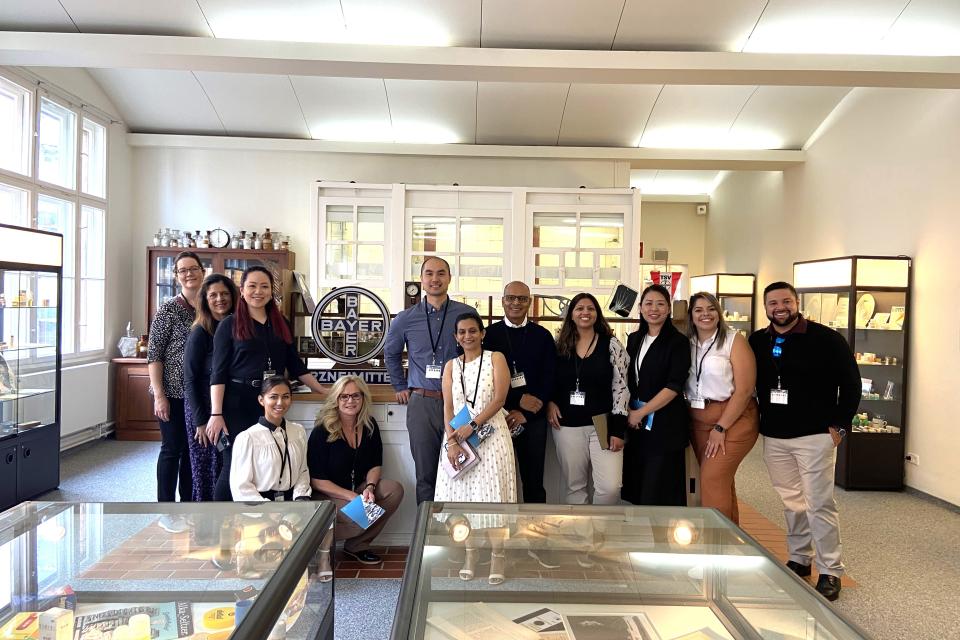
Postcard from Berlin: Our International Consulting Experience in the Heart of Europe
Presenting to clients in a city brimming with cultural diversity, warmth and innovation

UC Davis to Finland: A Summer of Gratitude and Exchange
My top 6 Reasons to Experience Summer Study Abroad
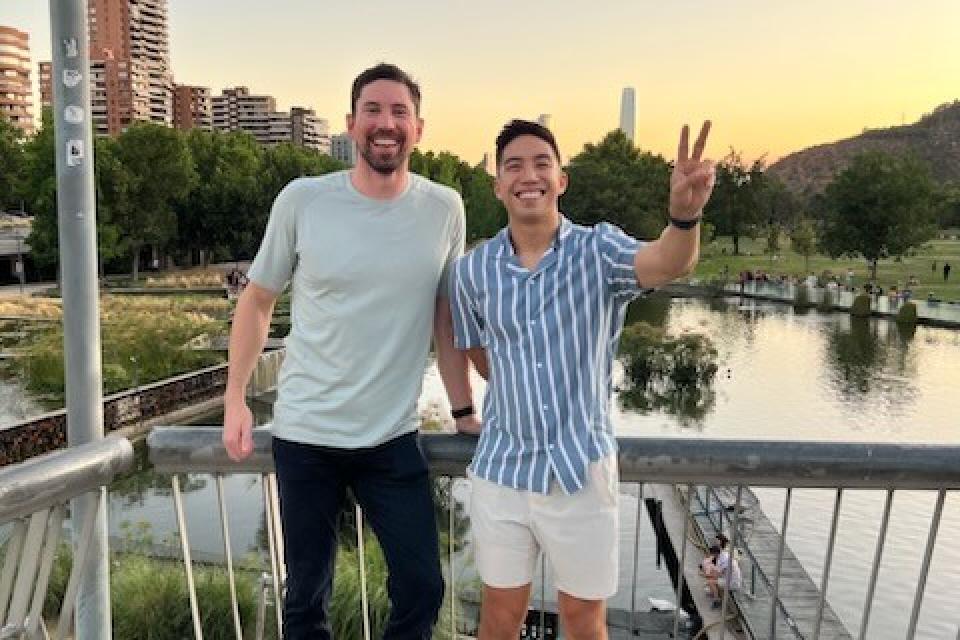
Business and Culture in Chile: Our Whirlwind MBA Study Trip
Exclusive company tours include mining, biotech, farming and winemaking

South Korea & Japan
Plus osaka world expo.
- INFORMATION
- Dates May 6 - 22, 2025
- Price From $ 8,995
- Deposit $ 600
- Trip Type History , Land , Nature
- Operator AHI Travel

- Contact Us [email protected]
- View Brochure Details
Experience the allure of South Korea and Japan on a first-class, 14-night adventure that features the highlights of Seoul, Busan, Kyoto and Tokyo!
- Included South Korea & Japan
FROM OUR GALLERY
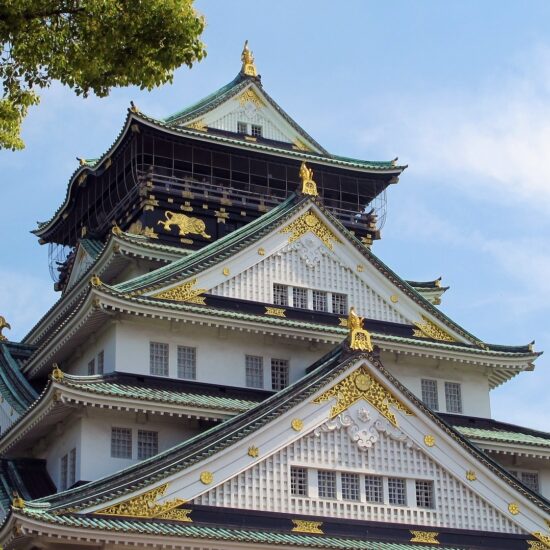

IMAGES
VIDEO
COMMENTS
Japan Railways Shinkansen operates a train from Kyōto to Tōkyō Station every 15 minutes. Tickets cost ¥11000 - ¥16000 and the journey takes 2h 18m. Alternatively, JR Bus Kanto operates a bus from Kyōto Station Karasumaguchi to Tokyo Station Nihonbashi Exit once daily. Tickets cost ¥4000 - ¥7500 and the journey takes 7h 51m.
Flying between Kyoto and Tokyo: Low-cost airlines. From US$26.43 *. one way (flight only) 90 minutes (flight time) + travel time to/from the airport. Kansai International Airport (KIX) to Narita Airport or Haneda Airport. Japan's fleet of low-cost carriers offer discount airfares between neighboring Osaka and Tokyo.
Find your train and book train tickets with Rail.Ninja - an independent online reservation service agency for train tickets. The best way to travel from Kyoto to Tokyo is by Shinkansen high-speed train. Check timetable, ticket prices, and book your tickets online with us!
The fastest Shinkansen (bullet train) is the Nozomi, which travels between Kyoto and Tokyo in a time of 154 minutes. The total cost is around ¥13,400 yen. While Japan Rail Pass holders cannot use the Nozomi (Japanese for hope), the Hikari (Japanese for light) takes only 20 minutes longer. From Kyoto to Tokyo there are four to five Nozomi ...
The one way trip from Tokyo to Kyoto by highway bus takes about 7-8 hours. There are daytime and overnight buses. Fierce competition on the Tokyo-Kyoto-Osaka route has produced a wide variety of comfort levels (from discount to super premium buses) and an abundance of low priced offers.
Shinkansen trains from Kyoto to Tokyo are definitely among the top choices when it comes to discoveringJapan wonders. Within 475 kilometers (295 miles) of each other, the cities are connected by one of the country's most scenic railroad routes, ideal for admiring the country's breathtaking landscapes, and served by the record-breaking Nozomi trains.
(Kyoto Station has a JR office that you can walk into and buy shinkansen tickets.) 👆 Kyoto to Tokyo train route: Sample train route from Kyoto Station to Tokyo Station. Explore the map. Adjust the departure time if necessary! The cost of the Kyoto to Tokyo shinkansen bullet train route is around 14,200 yen (around US$100) one-way without a ...
Find the best way to get from A to B, anywhere in the world, on your mobile or tablet. Compare your options: plane, train, bus, car, ferry, bike share, driving and walking directions all in one search. Train tickets from Kyoto to Tokyo start at ¥11388, and the quickest route takes just 2h 18m. Check timetables and book your tickets with Rome2Rio.
Tokyo and Kyoto are two must-visit cities. See them both with Klook and book train tickets for trips between Tokyo and Kyoto. You can travel from Kyoto to Tokyo by train as fast as 2h 0m, with tickets starting from just US$ 85.65. For most days, the earliest departure is 06:14 and the latest is 21:38.
The Takeaway. The shinkansen (bullet train) is the best way to travel between Tokyo and Kyoto. It takes around 2 hours and 15 minutes and costs Y13,080 between Tokyo and Kyoto (non-reserved seat). You don't need to reserve seats on the shinkansen if you travel outside of peak travel hours and outside of peak travel seasons.
Day 4: Travel to Kyoto, Explore Downtown Kyoto Take the shinkansen from Tokyo to Kyoto. The journey takes around 2.5 hours. For details, see our How to Travel from Tokyo to Kyoto page. You'll probably have some time after arriving in Kyoto to explore. We recommend checking out the downtown area on this day. Day 5: Kyoto: Southern Higashiyama
The path is a 2 km walk, which takes around 30 minutes—but leave time for temples and wandering. Nearest stop: Catch the bus Ginkakuji stop (numbers 5, 17 and 100) 3. Higashiyama District. Photo by Lily Crossley-Baxter. The narrow, winding streets of Higashiyama are exactly what you picture when you think of Kyoto.
Taking the Shinkansen from Tokyo to Kyoto. From US$88.00 *. 2 hours and 15 minutes (fastest service) Buy a one-way ticket on Klook or Rakuten Travel Experiences, or a JR Pass in advance. The Tōkaidō Shinkansen connnects Tokyo and Kyoto (and terminates one stop further, at Shin-Osaka Station).
Tokyo to Kyoto Bullet Train. Tokyo Station outside and inside. From Tokyo, you can board the shinkansen from either Tokyo Station, or Shinagawa Station. Nozomi trains run every 10 minutes from 6 to 9 pm, while Hikari trains run every 30 minutes from 6:26 to 10 pm. A one-way journey with an unreserved seat costs the same on all 3 shinkansen ...
The trip from Tokyo to Kyoto on the fastest train in Japan takes only about 2 hours. How often do bullet trains run from Tokyo to Kyoto? Nozomi bullet train from Tokyo to Kyoto has 31 departure per day every 30 minutes starting from 6:00 am. So you won't face any troubles adjusting your plans as Tokyo to Kyoto train timetable is quite versatile ...
Compare flight deals to Tokyo from Kyoto from over 1,000 providers. Then choose the cheapest plane tickets or fastest journeys. Flex your dates to find the best Kyoto-Tokyo ticket prices. If you're flexible when it comes to your travel dates, use Skyscanner's "Whole month" tool to find the cheapest month, and even day to fly to Tokyo from ...
Tokyo to Kyoto tours. From temples to tempura, onsens to okonomiyaki and skyscrapers to sake, join us for the ultimate Japan adventure. On a journey from the bright neon lights of Tokyo to the cultural capital of Kyoto, you'll see the best Japan has to offer - including the highlights and the hidden gems. Our Japan trips offer something for ...
April 18, 2024 · 3 min read. Embark on a 5-day cultural odyssey through the heart of Japan, exploring the historic streets of Kyoto and the vibrant cityscape of Tokyo. Begin your journey in Kyoto's Gion district, where traditional wooden machiya houses line the streets. Spend 2 hours soaking in the atmosphere before heading to the Yasaka-jinja ...
Shinkansen Bullet Train: fastest and comfortable. Bus: cheapest. Recommended itinerary for a day-trip to Kyoto from Tokyo. 1. Comfortable plan: Bullet Train round-trip. 2. Make the most out of your day: go by Bullet train and return by night bus. 3. Budget plan: round-trip by night bus.
Taking a train from Kyoto and Tokyo is a popular choice - it's affordable, hassle-free and usually frequent. Ticket prices on Klook start from US$ 86.05 and journeys can take 2h 0m. For most days, the earliest departure is 06:14 and the latest is 21:38. On Klook, you can find 131 journeys per day to choose from.
9 day itinerary in Tokyo and Kyoto. Departure city/airport : Tokyo (Narita : NRT or Haneda : HND) Tokyo (4 nights); Kyoto (4 nights); End Return airport : Osaka (Kansai international airport : KIX) Please find below the itinerary details. Tour length : 8 nights / 9 days (+ 1 day at the beginning if you leave from Europe) Indeed, the tour departure and end dates presented on this page relate to ...
Here's a sample itinerary for a drive from Kyoto to Tokyo. If you're planning a road trip to Tokyo, you can research locations to stop along the way. Make sure you check road conditions to double check the weather. Find the best hotels, restaurants, and attractions based on the most talked about places recommended by Trippy members.
Completing the scene are the serene reflecting pool and traditional Japanese gardens that contain lush foliage, manicured trees, and scenic walking paths. 1 Kinkakuji-cho, Kita-ku, Kyoto-shi, Kyoto, +81 075-461-0013, shokoku-ji.jp. Open daily 9am-5pm. Admission is 500 JPY. Admire Ryoan-ji Temple.
1 review. 1 helpful vote. Travel to Kyoto first then return back to Tokyo from S F? Apr 26, 2024, 9:47 PM. Hi, I plan to go to Tokyo , Kyoto and Osaka July 26 for 13 days or so from San Francisco, Ca. I am a bit confused whether I should travel directly to Kyoto first when arrive from Airport then return back to Tokyo since my departure flight ...
Most people getting a round trip flight ticket to Tokyo would choose to spend several days in Tokyo, then take the train to Kyoto, take the train back to Tokyo, and spend a few days in Tokyo before departure. This scenario gives you the opportunity to stay in 2 different neighborhoods in Tokyo.
Few consider venturing beyond the big cities of Tokyo and Kyoto, but for those who dare try, thrilling adventures await in Japan's best cities. From former homes of samurai warriors and current ...
On the Ground in Japan: Exploring Tokyo, Kyoto and Osaka. By mid-March, we were ready and excited to start the journey. I arranged to travel with my friend and classmate, Marissa Hernandez MBA 25. ... During our first leg of the trip, we went to Kyoto and Osaka. In Kyoto, we saw the Nishiki Market, Arashiyama Bamboo Grove, and Fushimi Inari ...
Fly to Kyoto to see a Heian-period palace, ancient temples and shrines. Attend the Osaka World Expo 2025, featuring innovative exhibits and cultural experiences. In Tokyo, drive along the stylish Ginza district, visit Edo-Tokyo Museum, see the towering Tokyo Skytree and stroll the Imperial Palace's Japanese gardens.